6
The Production Company Assumes Greater Control: 1900-1902
Creative responsibilities were rapidly centralized within the production companies during the first years of the new century. Nowhere was this more evident than with the shift of editorial control from exhibitor to producer. Responsibility for narrative construction accompanied this shift, ultimately making possible and valorizing the production company's claims to authorship. This far-reaching transformation was taking place in the film practices of other countries as well, notably of England and France. In the United States, the Edison Manufacturing Company not only led the way in this process but struggled with these complex issues in particularly revealing ways.
Porter Becomes an Edison Employee
By the fall of 1900 the Edison Company was reorganizing its Kinetograph Department and upgrading its technical system. Edwin Porter, with his mechanical ingenuity and experience, was the appropriate person to hire for the latter effort. The experienced operator had his own reasons for joining the Edison staff. His small factory for manufacturing projectors had recently been wiped out by fire.[1] Since traveling motion picture exhibitors were suffering through a difficult period, Porter was not eager to pursue such a commercial venture if other options were available. The exhibitor's admiration for Edison was undoubtedly another influential factor. In the end, Porter was added to the inventor's payroll a few days before Thanksgiving 1900. He was employed to "improve and redesign moving picture cameras, projecting machines and perforators," based on the superior equipment he had built and used at the Eden Musee.[2]
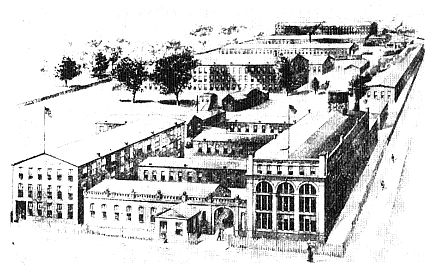
Edison Laboratory in West Orange, ca. 1900. Black Maria is in center.
According to Porter, "Mr. White, also Mr. Gilmore, recognized the superiority of my machine over theirs and they engaged me more as a technical man to improve their machine."[3] Edison advertisements described the 1901 Model Projecting Kinetoscope, which benefited from Porter's improvements, as "a complete revolution in projecting machines."[4] Besides the customary claims to a steady, flickerless image, the Edison machine "is equipped with the only perfect take up device which has ever been constructed to reel up 1,000 ft. of film without hitch or failure. Shows both stereopticon slides and animated pictures. One person can work the whole machine. It has a new adjustable arc lamp which is a marvel in itself. The lamp house is adaptable to any kind of illuminant known to the profession." By 1901, after having incorporated improvements from Albert Smith's vitagraph and the Eden Musee's cinematograph, Edison's projecting kinetoscope was among the best in its field. At a cost of $375 in labor and materials, Porter also constructed a new printing machine in January and early February.[5]
By the fall of 1900 the Edison Company had decided to build a new studio that would ensure a steady supply of films and improve its competitive position. The evident stabilization of exhibition outlets through vaudeville theaters made this appropriate. Because the demand for film programs had fluctuated between 1896 and 1899, relying on licensees to produce films and locate exhibition opportunities had kept expenses and risk low. Now that moving pictures were a permanent feature and exhibitors required a consistent supply of films, a new approach was merited. The result was the nation's first indoor, glass-enclosed film studio where pictures could be produced year-round—a definite improvement over both the Biograph and Vitagraph companies' open-air rooftop stages.
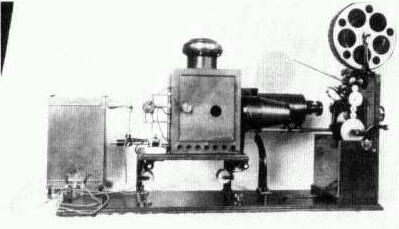
The Edison Projecting Kinetoscope, ca. 1901.
Unlike the Black Maria, the new studio was to be located in the heart of New York's entertainment district. All the personnel and materials needed for regular film production were at hand.
In October 1900 the Kinetograph Department rented the top floor and roof of 41 East Twenty-first Street for $150 a month. The Hinkle Iron Company was hired "to furnish, deliver and erect complete and in good substantial and workman-like manner a photographic Studio on roof" at a cost of $2,800.[6] The first expenditures for the New York studio were dispersed in December for "Pay Roll—Photo Gallery"—a total of $95.77. Another $10 was spent "hoisting 3 drums and shafting." On January 12, 1901, E. E. Hinkle announced that the building was complete after a mason had pointed up all the front and rear fireproof blocks at the studio. By mid February the studio was in working order.[7]
The Edison Company shared its space with Percival Waters' Kinetograph Company, which moved from offices across the street even before construction was completed. According to Waters, the space was
approximately 90 feet by 20 feet and on the roof above this floor there was a large studio occupying substantially the entire roof, fitted up especially for the purpose of taking moving pictures. . . . The proposition was made to me, and I accepted it, by which I was to pay the agent of the building monthly in advance $150., the entire rent for the top floor and the studio and I was to receive credit at the end of each month on my account with the Edison Company for $110, making my rent $40. The Edison Company was to have the exclusive use of the studio on the roof and a room approximately 8 × 10 feet lighted by a sky light and another room approximately 25 feet by 10 feet electrically lighted which was used as a dark room and dressing room and access to these two rooms through my place of business and the privilege of using the front rooms on my floor as dressing rooms. The company was also to have the use of
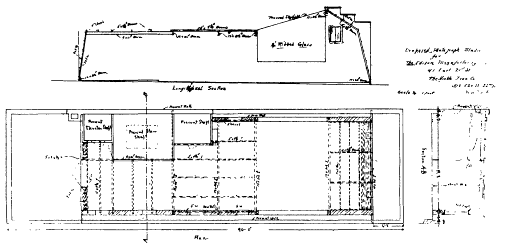
Blueprint for Edison's new motion picture studio on Twenty-first Street, New York.
the telephone, have such electric light as was needed and the use of my shop which I fitted up with a complete set of tools which they did use from time to time in connection with repairs to machines and cameras in connection with their operation of the studio and the producing of pictures there. They also had the use of my projecting machines for the purpose of exhibiting and testing their films.[8]
Porter recalled that "after being with [the Edison Company] a short time and as they were in need of a cameraman and producer, I was given charge of the first skylight studio in the country."[9] Porter actually had little experience as a cameraman; he was hired because of his considerable knowledge of cinematic practices and because his background as an electrician and machinist enabled him to put the studio in working order and to keep it that way. On staff, he was available to further improve the projecting kinetoscope and Edison's cameras. In addition, Edison executives needed someone who would not desert the studio if the inventor's patents suffered setbacks in the courts. Many of the more experienced cameramen could not have been trusted precisely for this reason. Porter's self-effacing manner, his emulation of Edison, and his lack of conflicting business interests all suited him to the company's needs. Also, studio productions did not then have the same importance—vis-à-vis news films and other actualities—that they were later to assume.
Porter's move into filmmaking occurred, moreover, within what might be called a collaborative system of production. Collaboration was, as already shown, familiar in the early years of film—whether between Porter and Charles H. Balsley, Dickson and Heise, White and Blechynden, or J. Stuart Blackton and Albert E. Smith. Now Porter shared his new responsibilities with George S.
Fleming, an actor and scenic designer who started working for the Edison Company on January 13, 1901. Fleming earned $20 per week, while Porter received only $15. This relationship with Fleming would provide Porter with a model for subsequent organizations of film work. In the years ahead, whether with Wallace McCutcheon, James Searle Dawley, or Hugh Ford, Porter would seek out a similar collaborative working method. Porter would feel most secure dealing with the filmic issues (camerawork, editing, special effects, camera tricks, etc.) and look to others to handle the actors. Although the stories and scripts for these subjects came from many sources, Porter would customarily shape them to his own sense of the commercially popular.
Although this collaborative system typified pre-Griffith film production, it has been little recognized. Janet Staiger has articulated the general historical consensus in characterizing pre-1907 filmmaking as relying on the "cameraman system." In the cameraman system, a single individual is responsible for the production of a given film.[10] The notion of a single cinematographer improvising short skits, or, more typically, traveling about the country taking actualities, resonates with the concept of early cinema as simpler and more "primitive."
The cameraman system was indeed employed during the pre-Griffith era, but then it was used in later years as well. The collaborative approach, with its informal exchange of ideas and sharing of roles, was more characteristic of the early period. Although this working method typically involved two key individuals, others also made contributions. Thus, James White assisted Porter and Fleming on such studio productions as Execution of Czolgosz and Life of an American Fireman . Collaboration, however, frequently went beyond Porter, Fleming, and White to include members of the staff whose contributions would never be expected (or even tolerated) in later, more hierarchical and labor-specialized organizations. While filmmakers of this period, including Porter, did occasionally have to work alone, this collaborative approach was preferred.
The new studio changed the balance of power between the Edison Company and its licensees. On January 10th, White and Gilmore terminated their licensing agreement with the talented, but difficult, American Vitagraph Company, after Blackton and Smith claimed that they were unable to pay a 10 percent royalty on exhibition income.[11] In the future, the Vitagraph owners were theoretically restricted to showing only Edison films. Though exhibiting European subjects in order to keep their business afloat, they ceased virtually all production activities. Only William Paley continued to operate under formal Edison auspices.
By mid February, Porter and Fleming were turning out short films; one of the first, Kansas Saloon Smashers , was the occasion for a rare publicity still. Excepting a few winter scenes (Ice-Boat Racing at Red Bank, N.J. ) and news films of McKinley's second inauguration (President McKinley and Escort Going to the Capitol ), most Edison subjects from the winter of 1901 were shot in the studio. Full-scale production of short comedies continued at Edison, while
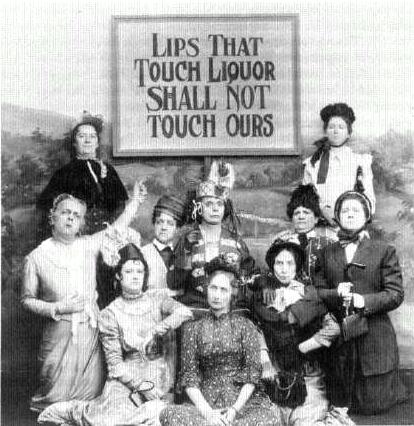
Publicity still for Kansas Saloon Smashers.
Biograph, with its outdoor facilities, suspended most production. Edison's investment was already paying off.
The Cinema as a Visual Newspaper
Until recently, historians looking at turn-of-the-century American cinema have generally dismissed it as naive, primitive, and unformed. Next to the consistent photographic realism of Lumière and the theatrical artifice of Méliès, American subjects have seemed eclectic, derivative, "literal and unimaginative," and "significant today mainly as social documents."[12] A more sympathetic and careful examination, however, reveals a unifying principle behind much American film production. As Robert C. Allen has pointed out, the screen was often described and conceived of as a "visual newspaper," where news items, human interest material, political satires, short cartoon-like sketches, and the sports page could all be combined within a variety format.[13] As Leslie's Weekly ob-
served of Edison's rival, "The Biograph goes hand in hand with the daily press in presenting to nightly audiences events which they have seen during the day or read of in the evening papers."[14] This came about, according to Harry Marvin, Biograph's vice-president, in response to audience demand:
In building up our business we were of the opinion at first that what the public would desire would be a series of finished and artistic pictures representing a scene or event of historic interest or artistic value. At first we followed such a course, but we soon found that the public demanded of us the prompt and reliable service of the daily newspaper rather than the artistic or aesthetic finish of the weekly or monthly magazine. That is to say, the public has expected us to gather the news in a pictorial way and disseminate it at once.[15]
If Biograph offered the visual newspaper par excellence, Edison subjects also owed much to this philosophy of production.
As the first form of mass communication and mass entertainment, newspapers profoundly influenced many cultural forms, including cinema. The mode of representation used by these papers included, at one end of the spectrum, the "objectivity" of the New York Times and the New York Tribune , which treated the reporter and the camera as recorders of reality and arranged the resulting stories hierarchically, based on their newsworthiness. The primary function of these papers was to inform and, through their editorial pages, to instruct their readership. At another extreme was the variety format of the Hearst papers, which were as interested in entertaining as in informing, preferring the sensational to the dry. In many instances, of course, the Journal did provide its readership with photographs and "objective" accounts of important happenings, but the comic strip suggests that amusement was also an important function.
The front page of the New York Journal was an excellent indicator of events considered worthy of the Kinetograph Department's attention throughout 1901-2. Kansas Saloon Smashers , first advertised as Mrs. Carrie Nation and Her Hatchet Brigade , portrayed the prohibitionist and her followers on a saloon-wrecking rampage that received front-page coverage.[16] The film was both reenactment and burlesque. While the set was based on a Journal photograph of a destroyed saloon in Wichita, Kansas, the characters and their actions owed much to the satirical cartoons appearing on the paper's editorial page.[17] Lubin's exhibition service showed the film at Bradenburgh's Ninth and Arch Street Museum, where the pictures were "declared to be genuine ones" and headed the entire bill.[18] This popular subject was promptly remade by both Lubin and Biograph. Later, when Carrie Nation's husband demanded a divorce, news reports inspired Edison's Why Mr. Nation Wants a Divorce .[19]
Terrible Teddy, the Grizzly King , a burlesque on Teddy Roosevelt, then vice-president-elect, who was shooting mountain lions in Colorado, was based on a political cartoon series also running in the Journal . In a panel printed on
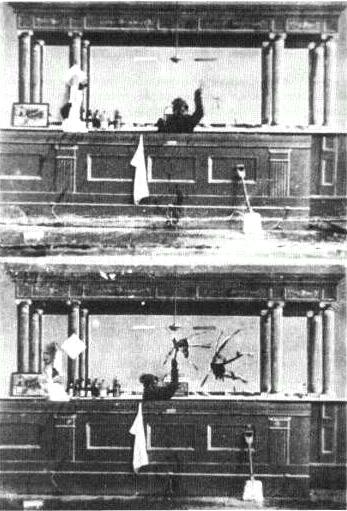
Kansas Saloon Smashers. A stop-action, concealed edit as
Carrie Nation destroys the saloon.
February 4th, the cartoonist showed Teddy perched heroically on a pile of animals while two men wearing small tags labeled "my photographer" and "my press agent" record the event in the background. The second scene was inspired by a panel that appeared on February 18th. As with the Carrie Nation film, Porter and Fleming were playing with a subject that enjoyed frequent satirical treatment. To offer but one example, Dumont's Minstrels were performing the burlesque "Teddy Roosevelt, the Bear Hunter" the very week that this film was made.[20]
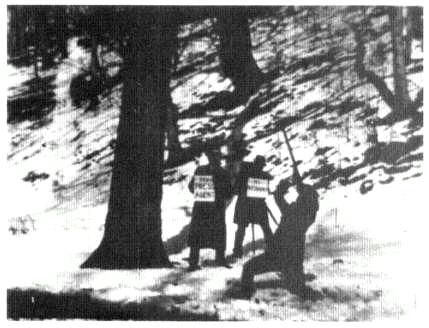
"My Photographer" and "My Press Agent" watch Teddy shoot a cat in the first
scene of Terrible Teddy, the Grizzly King.
Short screen comedies shared much with comic strips in the Sunday papers. The Happy Hooligan series, started by Blackton and Smith and continued by Kinetograph personnel, were indebted to the various cartoon strips depicting tramps ("Burglar Bill," "Happy Hooligan," and "Weary Willie") and appeared almost as regularly. The simple one-shot gags of Happy Hooligan April-Fooled (© April 6, 1901) and Tramp's Strategy That Failed (© May 15, 1901) are closest in their narrative structure to the Sunday strips. In these films, the humor revolved around the conflicts between constituted society and the outcast, with most situations ending with the tramp receiving an almost ritual beating.
The rube was another comic strip character who appeared in Porter/Fleming films. In Another Job for the Undertaker, The Hayseed's Experience at Washington Monument, Rube's Visit to the Studio, Rubes in the Theatre , and How They Do Things on the Bowery , this country hick encounters the modern mysteries of city life with costly naivete. In one comic strip, Uncle Reuben's unfamiliarity with "moving staircases" causes the loss of his bag and the "brick of gold" he has already been conned into purchasing.[21] In Another Job for the Undertaker , the rube's inability to read and his unfamiliarity with gas lighting cause him to blow out the flame, resulting in his asphyxiation and death. In How They Do Things on the Bowery , he is duped by a woman con artist, one of the many fast-talking city types to take advantage of his gullibility.
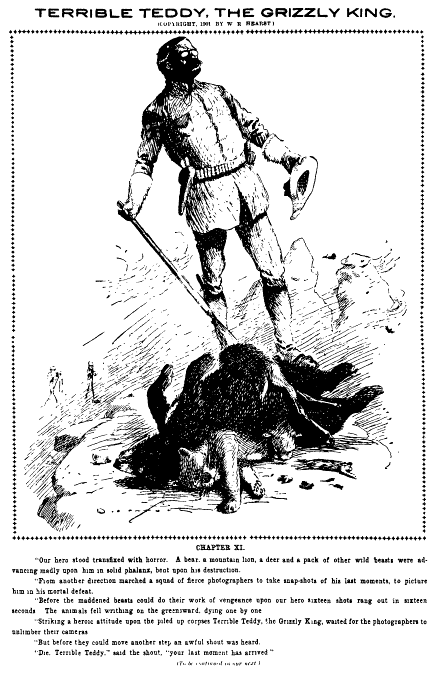
Cartoons provided the storyboard for Terrible Teddy, the Grizzly King.

Hearst's papers also combined information and amusement in ways disquieting to the journalistic standards of the highbrow press. The New York Journal published artists' sketches of news events, particularly when appropriate photographs were unavailable. What was lost in accurate reporting was gained in romantic melodrama. Sketches of battles were more visually dynamic than photographs of the trenches during periods of inactivity. Likewise a battle enacted for the kinetograph in the New Jersey hills provided a romantic realism that William Paley never matched when he photographed U.S. troops in Florida or Cuba. Artists' sketches appearing on the front page of the New York Journal dramatized the sensationalistic aspects of the Biddle brothers' escape from prison.[22] These were subsequently used by Porter and Fleming for the production design of Capture of the Biddle Brothers .
Perhaps the Journal's most distinctive use of visuals was the composite illustration that combined both drawing and photographic material. Such a syncretic amalgamation of disparate mimetic materials was at odds with the concept of a consistently represented, and therefore coherent, world that was then on the ascendency in the bourgeois theater and press.[23] Certainly it was inimical to the New York Times , which in any case continued to put far more faith in the word than the image. The representational strategies in Hearst's papers have parallels in much of early cinema, particularly in Porter's work at Edison. In Terrible Teddy, the Grizzly King , the natural, wooded location coexists with the cartoonist's tags still attached to the actors. The carefully constructed authenticity of the set for Kansas Saloon Smashers is seemingly contradicted by the painted mirrors and props along the back wall and with the stop-action photography of trick films used each time Mrs. Nation smashes a mirror. This syncretism, which has been denigrated as immature by historians accustomed to viewing Hollywood realism as a teleological endpoint, thus had its equivalent in long-standing cultural forms (e.g., theater, newspapers, the magic lantern).
Editorial Strategies
Most Porter/Fleming productions from the winter of 1901 were single-shot acted films between fifty and one hundred feet in length. These depicted a simple gag with a clear, though brief, Aristotelian construction—a beginning, middle, and end. In The Old Maid Having Her Picture Taken , the woman is so unattractive that when she looks into a mirror, it cracks and falls to the floor. When
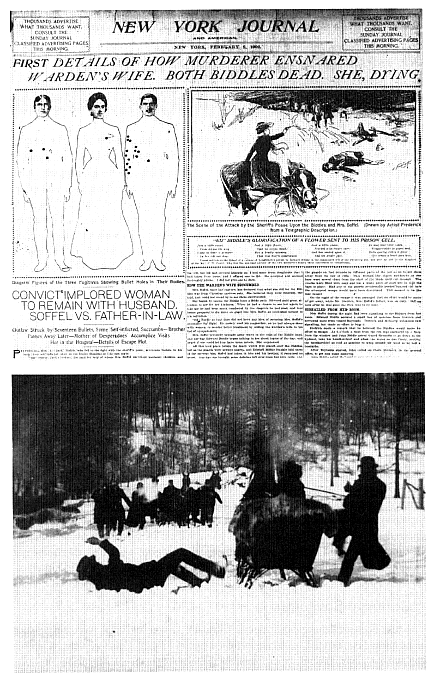
Capture of the Biddle Brothers.
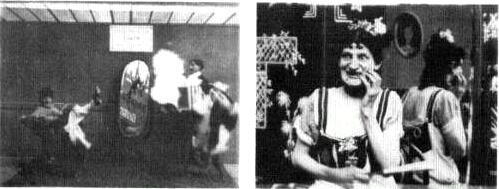
Exhibitors were urged to show Old Maid Having Her Picture
Taken and Old Maid in the Drawing Room as a larger unit.
she poses for a picture and looks into the lens, the camera explodes. This comedy featured Gilbert Saroni, a well-known vaudeville performer and female impersonator who specialized in playing unattractive old maids in vaudeville sketches like "The Giddy Girl."[24]The Old Maid in the Drawing Room (copyrighted as The Old Maid in the Horse Car ) was a facial expression film with Saroni photographed in close-up as he talked to the camera. "Her facial expressions are extremely humorous," declared one Edison catalog, "and when this picture was first shown in New York City, the audience was convulsed with laughter."[25] It was suggested that the old maid was busy talking about her adventures at the photo gallery. Thus, if an exhibitor desired, he could combine these two single-shot films to create a more elaborate subject. By giving the audience a better view of a face that was capable of destroying a camera, the exhibitor could introduce a self-reflexive element that only added to the farce.
From the outset, however, Porter and Fleming produced a significant number of multishot acted films, thus assuming control over the editorial function in select circumstances. The first scene of Terrible Teddy, the Grizzly King is described in an Edison catalog:
A burlesque on Theodore Roosevelt hunting mountain lions in Colorado and taken from the New York Journal and Advertiser. The scene opens in a very picturesque wood. Teddy with his large teeth is seen running down the hill with his gun in hand, followed by his photographer and press agent. He reconnoitres around a large tree and finally discovers the mountain lion. He kneels on one knee and makes a careful shot. Immediately upon the discharge of his gun a huge black cat falls from the tree and Teddy whips out his bowie knife, leaps on the cat and stabs it several times, then poses while his photographer makes a picture and the press agent writes up the thrilling adventure. A side splitting burlesque.[26]
In the next scene, unmentioned in the Edison catalog, the hunter and his retinue
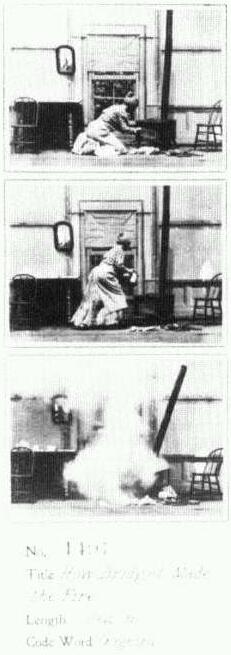
Biograph's How Bridget Made the Fire.
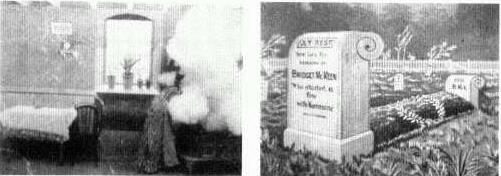
The Finish of Bridget McKeen.
are shown coming down a path: visual continuity and narrative coherence between the first and second shots are disrupted by the sudden appearance of a new pro-filmic element—Teddy's horse. Although Kemp Niver has suggested that there is continuity of space, time, and action between these two shots,[27] the inspiration for the scenes—two cartoon panels printed two weeks apart—offers contextual evidence that indicates this is unlikely. Not strong enough to stand alone as a separate subject, this second shot became commercially viable as a tag to the opening scene.
The Finish of Bridget McKeen , another two-shot comedy made in February, may have been inspired by Biograph's single-shot How Bridget Made the Fire , produced in June of the previous year. Other possible antecedents also existed. Like The Finish of Michael Casey , which Porter made a short time later, this ethnic joke was made at the expense of the "thick-headed" Irish. The first scene was filmed against the backdrop of a kitchen (including the far edge of the ceiling), with a stove, table, and chair as the only real objects on the set. The decor is a schematic, two-dimensional suggestion of a kitchen, just as Bridget, played by a male employee, is a burlesque of a maid rather than a believable portrayal. Using stop-action procedures, Porter replaced the actor, who is using a can marked "kerosine" to start the stove, with a dummy. After an explosion expels the dummy upward out of the scene, pieces of the body/dummy fall to the earth after an abnormally long time.[28] It is this distension of time that provides the scene with one of its key comic elements. The second scene is simply a static, painted backdrop showing Bridget's tombstone, on which is written the well-known ditty "Here Lies the Remains of Bridget McKeen Who Started a Fire with Kerosine." The relationship between the two scenes is easily understood, particularly for English-speaking audiences. Not only is the first shot the cause of the second, but the ditty recounts the previous scene even as it works as an effective punch line.
Another Job for the Undertaker , made two months after The Finish of
Bridget McKeen , has a similar narrative structure. Shot 1 is a typical trick film: when a rube enters his hotel room, its contents and his clothes quickly vanish. "He then walks up to the gas jet and in direct disregard of the sign (which reads 'Don't Blow out the Gas') proceeds to blow out the gas. Three vigorous breaths are consumed in extinguishing the light, when the Rube faces the foreground of the picture with a satisfied look and tumbles into bed. The scene instantly changes to a funeral procession, headed by Reuben's hearse and followed by carriages of his country friends."[29] The second shot was filmed outside using procedures associated with actualities. The editorial combination of disparate mimetic elements is consistent with Porter's use of painted and real pro-filmic elements within a single scene. The syncretic mode of representation is simply taken to another level, utilizing editorial strategies that Porter had learned well as an exhibitor.
Terrible Teddy, the Grizzly King, The Finish of Bridget McKeen , and Another Job for the Undertaker share many characteristics. The first scenes are self-contained narratives constructed like many single-shot films of the period. The only significant difference is the addition of a tag, a short fragment that gained its value in reference to the principal scene. Each tag also represents a shift in representational methods, from narrative to non-narrative, from theatrical to painterly, from trick to actuality, or from movement to stasis. The photographer's editorial prerogatives were still confined to specialized situations. Within these limited possibilities, the films lack phenomenological continuity from one shot to the next: their relationships are aspatial and atemporal. Continuity is restricted to a narrative or thematic level. Porter had not begun to explore the spatial and temporal relations that were to become fundamental to later narrative cinema.
Two multishot films made early in 1901 are significant for yet another reason: they made use of a dissolve. In The Finish of Bridget McKeen , Porter dissolved between the main narrative gag in the kitchen and the tombstone tag. In Why Bridget Stopped Drinking , made about the same time but not copyrighted, Porter used a single camera position for both shots—the dissolve smoothing and clarifying the jump in time. The dissolve, a common screen technique developed in the mid nineteenth century, was executed by exhibitors during the course of projecting slides.[30] It was considered a particularly elegant way to move from one image to the next, preventing sudden jumps when scenes changed. In the late 1890s exhibitors occasionally dissolved from film to film or film to slides, but with mixed success.[31] The technique was not only tricky but required good timing, considerable equipment, and an extra assistant. In transitions from film to film, it was possible and much more practical for dissolves to be made in the motion picture camera or during the printing process. Méliès' Cinderella , which Porter projected at the Eden Musee, was perhaps the first film to contain dissolves: this technique was soon adopted by Blackton and Smith for Congress of Nations . Porter then employed it regularly during 1901-2, con-
cluding with Life of an American Fireman . If nothing else, it gave the production company new opportunities to assume control over the editorial process.
A group of studio films in late April and early May featured the dog known as "Mannie," who appears with his owner, Laura Comstock, in Laura Comstock's Bag-Punching Dog. The film begins with a close view of the duo and then cuts to a vaudeville-type routine probably taken from their act then being performed at Keith's Union Square Theater. Prospective purchasers were told that Mannie's "high jumps and lightning-like punches are remarkable and cause one to marvel at the amount of patience that must be necessary to teach a dog such tricks."[32] The introductory portrait functioned much like the facial expression film in the suggested combination of two Gilbert Saroni comedies discussed above. Here the producer asserted editorial control because the portrait was not strong enough to be sold on its own. It was also placed at the beginning of the picture rather than at the conclusion. Both uses of "emblematic shots" are innovations that can apparently be attributed to Porter, and yet here again caution and qualification are essential. Lantern-slide portraits of Spanish-American war heroes had often been exhibited in conjunction with related scenes. Thus, a portrait of Captain Sigsbee might have preceded the film of his ship, the Maine . Porter, therefore, applied his expertise as an showman to new material and a new situation. It was a significant achievement, but hardly an unexpected departure from previous practice.
Norman H. Mosher—Laura Comstock's husband, her manager, and Mannie's trainer—developed a relationship with Porter that would endure for over five years, during which time Mannie appeared in many Edison productions.[33] At the outset of this association, Mannie played the tramp's nemesis in several Happy Hooligan films. Pie, Tramp and the Bulldog consists of one "shot" of three separate camera takes (or subshots): (1) the tramp indicates to the film spectators that he is hungry, but that the bulldog prevents him from getting to the pie cooling on a nearby window sill, and so he exits the frame; (2) the tramp immediately returns on stilts to outsmart the dog and eat the pie on the ledge; (3) the dog gets the tramp by jumping out the house window, and the two exit with the dog holding onto the tramp's pants. Here Porter spliced together a succession of takes taken from a single camera position to give the illusion of a single, uninterrupted continuity. Rather than using this procedure to create a "trick," he used it for pacing purposes and to construct a narrative that would have been difficult to execute during a single take. (The time occupied by the tramp's off-screen acquisition of stilts was condensed in a way that obeyed theatrical convention.) Pie, Tramp and the Bulldog was praised in a subsequent Edison catalog: "This we believe to be one of the funniest pictures ever put on exhibition. It has had a run of five weeks at Proctor's New York Vaudeville Theatres and the audiences never seemed to tire of it."[34] With the studio in operation only a few months, Porter and Fleming were proving themselves adept producers of short comedies.
The Tramp's Dream , another film in this series, meticulously imitated a Lubin picture of the same title made in late 1899.[35] (Clearly Edison personnel were as ready to "borrow" from their contemporaries as vice versa.)[36] The picture has a more complex shot structure than Porter's previous films: shot (1) the tramp goes to sleep on the park bench; shot (2) the dream—the usual confrontation between the tramp, who wants a free meal, and the dog, which grabs the tramp by his pants; shot (3) a return to shot 1, the tramp is being hit on the foot and shaken by a passing policeman. The last shot explains why the dream ends and also reinforces the parallelism of the tramp being attacked by the dog and the patrolman: he gets no rest in either his dream world or his real world. Not only is there temporal continuity (although its precise nature is not defined), but a movement into and out of the tramp's mind. Subjective images, whether dreams, visions, or a character's subjective "point-of-view," were among the first instances in which cameramen employed sophisticated editorial strategies that created spatial and temporal relations between shots.[37]
Spring 1901
That spring, Edison production moved back outside the studio. Porter probably took Buffalo Bill's Wild West Show Parade , which "shows Buffalo Bill and his family of Rough Riders on their triumphal entry in New York, April 1, 1901."[38] Over the following weeks, Wild West Show performances in Madison Square Garden included "the hold-up of the Deadwood Stage."[39] This may have inspired or even provided the necessary actors and props for another Edison film made that spring—Stage Coach Hold-up in the Days of '49 :
This scene will give you a good idea of the desperate "Hold-Ups" that occurred on the plains when the rush was made to the new gold fields in '49. It shows the desperadoes coming from ambush, covering the driver of the stage with Winchester rifles and ordering him to halt. The occupants of the coach are compelled to dismount from their places, and are lined up in a very realistic manner with their hands thrown up. The outlaws get all the booty they can, and are just departing when an armed Sheriff's posse arrives. They pursue the bandits and after a desperate chase and a brutal conflict, capture them and return to the scene of the robbery. The bandits are then forced at the points of revolvers to ride in front of the coaching party to Dad's Gulch, a mining town, where they are safely landed in the lock-up. This picture will joyously intoxicate any audience, and deafening applause for an encore will be certain. Length 150 ft.[40]
Stage Coach Hold-up might answer several historical questions even as it raises others. It is a possible model for the British film Robbery of a Mail Coach (September-November 1903) as well as a precursor of Porter's later The Great Train Robbery .[41] While the description may be a somewhat expansive version of what was actually shown on the screen, the picture could have contained as many as four shots. Unfortunately it is a lost film and the catalog description
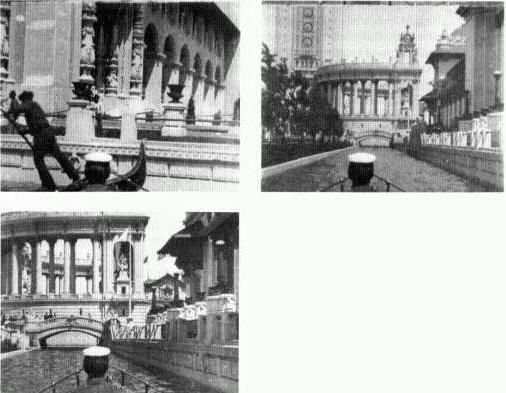
A Trip Around the Pan-American Exposition makes use of the viewer-as-passenger convention.
provides no certain answers to its possible construction. The historian must look elsewhere to trace the development of film narrative at Edison.
After the success of its Paris Exposition subjects, the Edison Company spent considerable energy securing films of the Pan-American Exposition in Buffalo, New York. Again a mobile camera was heavily employed. A camera crew, probably including James White as producer and Edwin Porter as photographer, took the two-shot Opening, Pan-American Exposition , showing a parade of dignitaries and soldiers, on May 20th. This was soon followed by A Trip Around the Pan-American Exposition , a 625-foot subject photographed from a launch making a tour of the exposition's canals. The camera was assigned the role of privileged passenger and took in all the sights. This popular subject was also sold in 200, 300, 400, or 500-foot strips, depending on the desires of the exhibitor. For Panoramic View of Electric Tower from a Balloon , the camera caressed the electric tower with a vertical tilt up and down, recalling White's earlier treatment of the Eiffel Tower in Panorama of Eiffel Tower . The title
and catalog description, however, urged exhibitors to test their patrons' imagination—or gullibility: the camera, it was suggested, had been in a captured balloon that moved up and down next to the tower. By the beginning of June they had accumulated over twenty films, including Johnstown Flood, Aerio-Cycle , and Trip to the Moon —short scenes taken of specific attractions.[42] Once again, these were designed for longer, theme-oriented programs in which exhibitors asserted an authorial role. To facilitate these efforts, the Edison firm published a "Pan-American Supplement" that provided full descriptions of each film as material for the showman's live narration.[43]
A significant group of photographers were associated with the Edison Company by early 1901. Although William Paley was the only surviving licensee on the East Coast, William Wright or some other Edison-affiliated cameraman must have filmed President McKinley launching the battleship Ohio in San Francisco before a crowd of 50,000 cheering people.[44] Since late 1898 James White may occasionally have served as his own cameraman, but more typically he worked with Porter or Alfred C. Abadie when producing news films and actualities. Porter may have emerged as the only close to full-time Edison camera operator. The extent to which his collaboration with George S. Fleming continued outside the studio is unknown. Two Edison production units were active on May 30th, Decoration Day: Porter was probably in Ithaca, New York, taking Cornell-Columbia-University of Pennsylvania Boat Race , while another unit was at an amusement park filming Shooting the Chutes at Providence, Rhode Island .
While Edison cameramen were filming actualities all over the northeastern United States, Porter spent much of his time producing short comedies and trick films at the Edison studio and in nearby locations. Building Made Easy, or How Mechanics Work in the Twentieth Century (85 feet) used stop and reverse action to show a bricklayer and carpenter working effortlessly, constructing a building in ways that defied gravity. The building of New York's subway was the premise for The Finish of Michael Casey , yet another explosion film. Little Willie's Last Celebration , made to commemorate the Fourth of July, likewise ends with Willie in smithereens. Unfortunately these pictures were not copyrighted and do not survive.[45]
Edison Attains a Virtual Monopoly
On July 15, 1901, a decision recognizing Edison's patent claims was handed down in the U.S. circuit court for the southern district of New York. Judge Hoyt Henry Wheeler's tentatively worded opinion concluded: "The defendant appears to have taken the substance of the invention covered by these claims and the plaintiff, therefore, appears to be entitled to a decree."[46] While the defendant, the American Mutoscope & Biograph Company, appealed to a higher court, it was allowed to continue operating under certain restrictions.[47] Yet even before Edison's victory, Biograph was struggling with financial adversity. That
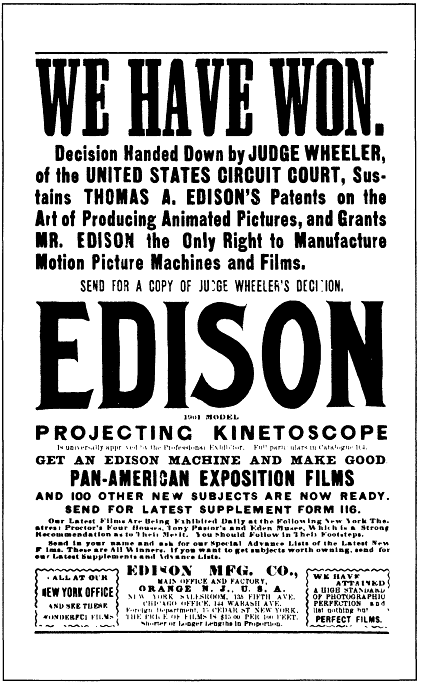
New York Clipper, July 27, 1901, p. 480.
spring, the company had begun to lose money, a situation that continued well into 1902, if not beyond.[48] Its moving picture service was becoming less profitable and popular because the company was limited by its 70mm film format. Whereas exhibitors such as Vitagraph and George Spoor's Chicago-based Kinodrome Service could show European imports like Méliès' Cinderella on their 35mm projectors, Biograph could not do so. Biograph's logical move was to switch to a 35mm format, but its executives dared not do this, as their special-sized film could have provided a decisive distinction between the Edison and Biograph systems from a legal standpoint. The cost of litigation and the impact of Judge Wheeler's decision only furthered Biograph's decline.
Other "disruptive" elements within the industry were also affected by Judge Wheeler's decision. The Edison Company had hired Sigmund Lubin's chief photographer, Jacob (James) Blair Smith, starting July 14th. Smith, who assumed William Heise's old role, enjoyed a high weekly salary of $25 a week ($10 more than Porter's) because he could testify concerning Lubin's infringement on Edison's patents. As a result, after consulting with his lawyers, Lubin relocated to Germany.[49] With Lubin knocked out of competition, Vitagraph reduced to the role of exhibitor, and Biograph locked into a large-format film and on the commercial defensive, the Edison Company was on the verge of controlling the motion picture industry in America.
Edison's victory in the courts encouraged other holders of motion picture patents to negotiate a settlement. Thomas Armat, whose Armat Moving-Picture Company held important projection patents, was anxious to form a combination. To Thomas Edison, he argued that
Years have gone by and your proper profits in the business have not yet I believe materialized. The same is true of me. Every year cut off from my enjoyment of the fruits of my toil is a matter of loss. In looking over the field I am more and more convinced that the situation can be made to bear the full success of our hopes in but one way—by the formation of a trust into which you will throw your film patent, the Armat Company the Armat patents, and the American Mutoscope and Biograph Company its Mutoscope patents, together with a withdrawal of all further appeal on your film patent.
This combined action would establish a real monopoly, as no infringer would stand against a combination of all these strong elements. The way things are now the woods are full of small infringers who are reaping that which belongs to yourself and ourselves. . . . There is big money in all ends of this business if properly conducted and little in it otherwise.[50]
Armat's proposal revived earlier attempts at consolidation by Biograph and anticipated the combination of forces that eventually formed the basis for the Motion Picture Patents Company late in 1908. The trust Armat envisioned would, however, have centralized all activities within a single production office and hobbled the American industry for years. Although Armat and T. Cushing Daniel held meetings with Edison and Biograph, they could not agree on
the terms. Armat tended to view the projection patents as paramount, while Edison felt the same about his own position. The actual formation of a patents trust was to wait another six years until similar circumstances once again presented themselves.
When Edison's lawyer Howard W. Hayes learned of Edison's court victory, he sent Gilmore his congratulations from Europe and then asked:
Will it not be worth while to spend a little more money now in getting out a better class of films? I was surprised to find what good films they have here in Paris, they are very clear and with no jumps. Whenever any important even[t] happens like the Henley Boat Race, the films are on the market within two days afterwards.[51]
J. B. Smith, for one, helped to address some of these concerns. As foreman of the Edison film plant, Smith soon "made many improvements in the machinery and methods of taking and making pictures. At that time it required an hour to perforate 200 feet of film on a step punch which time has reduced to just one-third; it took 20 minutes to print the same length of film on what was known as continuous printers, which were succeeded by stop motion printers, which accomplished the same task in from six to seven minutes according to the density of the negative."[52] Smith, like Porter, was not only a cameraman but a mechanical expert.
The Edison Company continued active production in the wake of its court victory. Soubrette's Troubles on a Fifth Avenue Stage and What Happened on Twenty-Third Street, New York City appear to be ordinary street scenes at first, but each shows a woman unexpectedly revealing a significant portion of her undergarments. Both films featured A. C. Abadie as the swell and Florence Georgie as the unfortunate woman. In the latter picture, her dress is blown up when she steps over a Herald Square blow hole (anticipating Marilyn Monroe by fifty years).[53] Again, as Judith Mayne has pointed out, this is a film that appealed explicitly to male spectators.[54] Georgie's giggles reassure the spectator and authorize his look. Likewise the use of theatrical display and the performers' acknowledgment of the camera were perhaps necessary means of allaying the spectators' discomfort at an unexpected encounter with a forbidden, voyeuristic pleasure. Tom Gunning has called early cinema an exhibitionist cinema rather than a voyeuristic one as Christian Metz defines it. While this may be true, historically this rupturing of a self-enclosed fictional world usually mediated the spectators' experiences in ways that facilitated their voyeurism, not undermined it.[55] This is evident in Trapeze Disrobing Act , made that fall. The performer in this studio production was probably Charmion, whose "risque disrobing act on the flying trapeze" was popular at the turn of the century.[56] Although her striptease was performed for the camera and cine-viewers, the two male spectators inside the mise-en-scène authorized the film spectators' voyeurism. Such pictures were so "hot" that the Victorian males' repressive psychic mechanisms had to be allayed if these patrons were to find the intended pleasure rather than
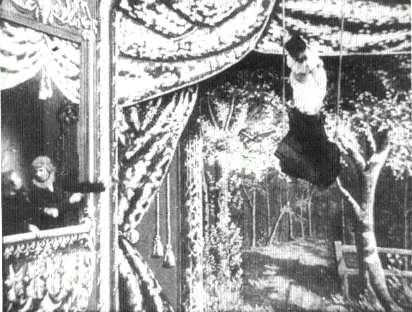
Trapeze Disrobing Act.
unpleasure in their voyeurism. Produced for burlesque houses and "smokers," these films were by male filmmakers and for male spectators.
In contrast, one-shot comedies such as The Tramp's Miraculous Escape and The Photographer's Mishap were suited for "polite" vaudeville with its mixed-sex audiences. Both were photographed along train tracks, using stop-action techniques to simulate a train colliding with its victim.[57]Weary Willie and the Gardener and The Tramp and the Nursing Bottle , part of the tramp series, were shot in a park or in someone's backyard. Each recycled an earlier film gag. All of these comedies were made quickly and at minimal expense.
During their first six months, Porter and Fleming assumed editorial control only in highly circumscribed situations, chiefly by adding dependent tags as endings to one-shot comedies. Two films made in August and September 1901 suggest that they were moving beyond these constraints: Life Rescue at Long Branch and Sampson-Schley Controversy. Life Rescue at Long Branch , retitled Life Rescue at Atlantic City for the Edison catalog, presented a two-shot, staged rescue by lifeboat. It was a popular subject that Sigmund Lubin had filmed in Atlantic City during 1899. Lubin's Life Rescue was "the most wonderful picture ever taken. Two people went out too far in the ocean to bathe; the gentleman was drowned, the lady saved by the life guards, who can be seen swimming out to her."[58] The Edison film shows two different parts of a rescue, and connects
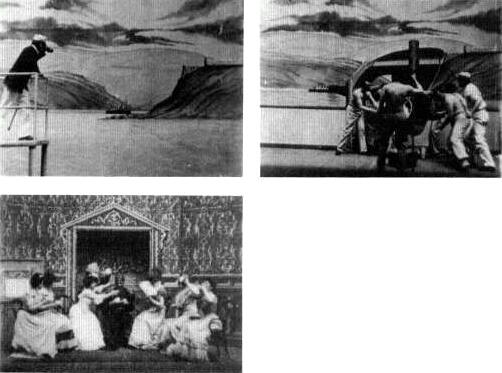
Sampson-Schley Controversy.
them with a dissolve. The major distinction between Life Rescue at Long Branch and earlier rescue films such as Ambulance Call and Ambulance at the Accident is the dissolve that ties the shots together and the corresponding assertion of editorial control by the cameraman/producer. It moved beyond the limitations of earlier Edison acted films as two shots of equal weight told a simple linear narrative. The film was more modest than James Williamson's Fire! made in England two months earlier, but it represented a minor advance in the Kinetograph Department's approach to filmmaking.
Sampson-Schley Controversy was based on an argument between two naval officers that had erupted onto the front pages of the popular press. The controversy concerned a naval battle in Santiago Bay during the Spanish-American War, the actions of the two principal American officers, and the question of who ultimately was in command. A political cartoon in Hearst's New York Journal provided Porter with a sketch for his film.[59] Since the cartoon reflected his own political sentiments, Porter probably found it an attractive subject to adapt.[60]
Sampson-Schley Controversy was first copyrighted as a two-shot film on August 15th and offered for sale. It was puffed in Edison advertisements as:
The greatest naval and dramatic Production ever attempted in animated pictures. Admiral Schley is depicted on the bridge of the "Brooklyn" commanding the American Fleet which is engaged with the Spanish fleet. A portion of Schley's crew appears in the immediate foreground of the picture furiously working a 13 inch gun and giving a dramatic demonstration of the famous picture "The Man Behind the Gun."[61]
The scene of Winfield Scott Schley on the bridge, which conforms to the first panel of the cartoon, is enhanced by the second shot, in which one member of the gun crew is killed. This illustrated a well-known incident of the battle in Santiago Bay, when Boatswain Ellis was killed and Schley insisted that his body remain on deck until it could be given a proper Christian burial.[62] Schley's conduct is associated with the actions of these courageous common sailors, while William T. Sampson was well known for his aristocratic pretensions.[63] Although mentioned in the title, Sampson was never shown in this version of the film. George Kleine thought that a more appropriate title would be Schley on the Bridge and Man Behind the Gun ; certainly it reflected the film's two-shot structure.[64] The sets were similar in both shots and used extreme theatrical foreshortening, with model boats in the far background representing the Spanish enemy.[65] The camera's framing of an identical background is slightly different in each shot, suggesting that the two scenes occur on different parts of the ship. The temporal relation between the two shots is vague, but potentially significant in light of Porter's later films: the relative positions of the model boats and the characters' behavior in each shot suggest a temporal repetition. It appears that these two aspects of the same battle occur simultaneously, but are shown successively on the screen.
Three weeks after its initial release, Porter added a final scene to Sampson-Schley Controversy . This was based on the second panel of the cartoon: "The conclusion of the picture shows Admiral Sampson at an afternoon Tea Party, the center of an admiring group of old maids. Length 200 ft."[66] A dissolve between the last two shots was achieved in the printing. The cartoon strip points out that Schley's actions on the Brooklyn occurred while the admiral was at a tea party. Contextual information thus indicates that all three shots of the Sampson-Schley Controversy represented actions occurring at the same time. The film raised the problem of depicting simultaneity, which Porter would confront again in later work. In the Sampson-Schley Controversy , however, this temporal simultaneity is only implicit. Audiences familiar with the cartoon or the controversy may have made the connection, or it may have been made for them by the showman. While temporal relations between shots were implied within the film itself, it was the exhibitor's or the spectator's task to define them more explicitly.
In expanding Sampson-Schley Controversy to three shots, Porter used his experience as a showman to produce a simple contrast: the man behind the gun/the man behind the tea cup. The use of contrast was an editorial strategy often employed by exhibitors. In an earlier Biograph program the operator showed a series of "couplets," including Blizzard in New York City/A Little Ray
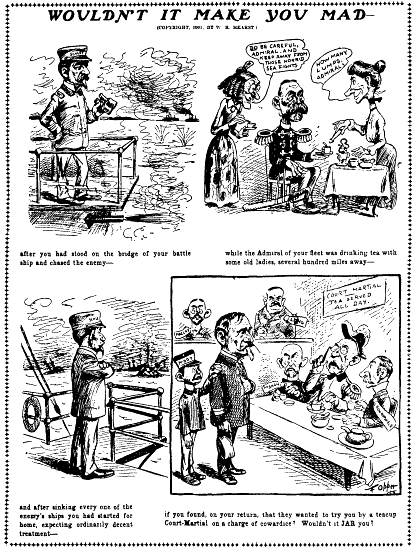
A political cartoon in the New York Journal inspired Sampson-Schley Controversy.
Captions established the temporal relationship between scenes.
of Sunshine and Cremation/Hatching Chickens .[67] Similar combinations had also been suggested by slide producers for pre-cinema lantern shows. Clearly Porter had appropriated editorial responsibility formerly within the domain of the exhibitor to make a political comment. The acceptance of this new role was still limited: Kleine, for instance, was a Republican who may have sympathized with
Sampson and so chose not to sell the last scene-essentially registering an editorial veto. Although the film could still be used by showmen either within a variety format as a political editorial or as part of a larger program on the Spanish-American War (such programs continued to be popular), the tension between cameraman/producer and showman/exhibitor with regard to editorial responsibility had emerged as a central issue.
Mckinley Pictures
When President McKinley went to the Pan-American Exposition early in September 1901, James White and an Edison camera crew were present to take advantage of their special photographic concession. On September 5th they took a simple one-shot film of McKinley delivering a speech that praised American business, competition, and the tariff. The next day, while holding a reception in the Temple of Music, the president was shot in the chest and abdomen by Leon Czolgosz, a Cleveland anarchist. The Edison crew, waiting outside, took a "circular panorama" of the anxious crowd soon after the assassination was announced. Suddenly, the Edison Manufacturing Company had a moving picture exclusive on the biggest news event of the new century: "Our cameras were the only ones at work at the Pan-American Exposition on the day of President McKinley's speech, Thursday September 5th and on Friday September 6th, the day of the shooting. We secured the only animated pictures incidental to these events."[68] Three films, fewer than first announced, were offered for sale: President McKinley's Speech at the Pan-American Exposition, President McKinley Reviewing Troops at the Pan-American Exposition , and Mob Outside the Temple of Music at the Pan-American Exposition .[69] Shortly thereafter, frame enlargements were published in the New York World , along with a brief article featuring White's role and mentioning several anonymous employees, almost certainly including Edwin Porter and J. Blair Smith.[70]
When President McKinley died a week after the shooting, Edison employees filmed the funeral ceremonies as they moved from Buffalo to Washington to McKinley's hometown of Canton, Ohio. Eleven films were offered for sale. These were no longer simple, single-shot subjects comparable to those the Edison Company had sold during the Spanish-American War. Most scenes, such as Taking President McKinley's Body from Train at Canton, Ohio , consisted of several shots that were too brief to be easily sold or exhibited individually. With the Edison Company anxious to get these groupings of moving snapshots on the market, they released unedited camera rushes that included flash frames.
When purchasing the McKinley films, exhibitors had two basic choices: they could either acquire single subjects for their programs or purchase a prearranged selection of subjects joined together by dissolving effects. The Complete Funeral Cortege at Canton, Ohio (675 feet) is one example of this second option. The order given by the Edison Company was:
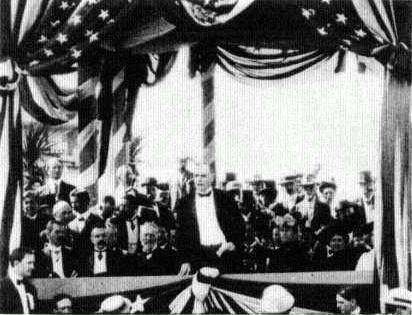
McKinley's last speech.
Arriving at Canton Station (40 feet)
Body Leaving Train at Canton, Ohio (60 feet)
President Roosevelt at Canton Station (90 feet)
Circular Panorama of President McKinley's House (80 feet)
President McKinley's Body Leaving the House and Church (200 feet)
Funeral Cortege Entering Westlawn Cemetery at Canton, Ohio (200 feet)[71]
Dissolving from scene to scene, the production company was able to give the exhibitor a standardized program with a little something extra.
Many, perhaps most, exhibitors chose not to abdicate their editorial role. A programme from the Searchlight Theater in Tacoma, Washington, shows that a different selection was made for its display of McKinley films. The traveling exhibitor Lyman Howe also devoted a substantial portion of his semiannual tour to films of the Pan-American Exposition and McKinley's funeral, but presented yet another selection and ordering.[72] Although a programme does not survive for John P. Dibble's presentations, this New Haven-based traveling showman began with films of the Pan-American Exposition, included McKinley's last speech, and ended with the funeral ceremonies.[73]
Exhibitors enjoyed a financial windfall as people flocked to see the
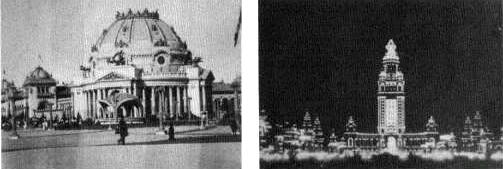
Pan-American Exposition by Night goes from day to night as the camera makes a sweeping pan of the exposition.
McKinley/Exposition films. Edison likewise benefited. From October to December 1901, when these films were in greatest demand, the Kinetograph Department set a sales record unmatched during any three-month period between 1900 and 1904.[74] Porter and his associates continued to exploit this trend with The Martyred Presidents (© October 7, 1901), a film indebted to nineteenth-century magic-lantern subjects like Our Departed Heroes .[75] In the film's opening scene, photographs of Lincoln, Garfield, and McKinley fade in and out, framed by the static image of a monument. The second shot, a brief tag, shows the assassin kneeling before the throne of justice. The dissolving on and off of photographs, once done by the exhibitor in lantern shows, was now done by the moving picture photographer. While the catalog considered the film "most valuable as an ending to the series of McKinley funeral pictures,"[76] the question of its placement in a program was a decision left to the exhibitor.
Kinetograph personnel invested further energies in the Buffalo area during mid to late October. Shortly after making The Martyred Presidents , Porter photographed Pan-American Exposition by Night[77] While Porter and subsequent historians referred to this film for its early use of time-lapse photography, its two-shot construction is also noteworthy. There is a pan in the first shot taken during the day that is continued from the same point, in the same direction, and at the same pace in the second shot filmed at night. Here Porter combined two common stereopticon procedures. The temporal relation between the two shots is characteristic of day/night dissolving views, a popular genre of lantern show entertainments: the image of a building during the day gradually dissolved to the identical view at night (the second view was often produced by using a day-for-night technique). The panorama as a genre pre-dated the cinema by more than a hundred years and found its way into many forms of popular culture, including lantern shows, for which long slides were slowly moved through the lantern. In 1900 it was adapted to moving pictures as the "circular panorama,"
with the photographer rather than the projectionist responsible for the speed and direction of the movement. The combination of day/night dissolving views with a panorama in moving pictures was a visual tour de force. "This picture is pronounced by the photographic profession to be a marvel in photography, and by theatrical people to be the greatest winner in panoramic views ever placed before the public," declared the Edison catalog.[78]
The principle of multi-camera coverage, which the Edison Company had applied to important news events in the late 1890s, continued, not only with the McKinley funeral pictures but for Captain Nissen Going Through Whirlpool Rapids, Niagara Falls , photographed on October 10, 1901. As an Edison description explained,
Captain Bowser is shown embarking in his boat at Niagara Falls, Ontario. After he carefully embarks, the 'Fool Killer' is taken in tow by a rowboat and towed out into the stream. Here the captain is seen to go below the whaleback deck and close the hatch. Then the trip through the Rapids begins. One of our cameras, which was operated by a second photographer, was in waiting on a trolley car, and the progress of the 'Fool Killer' is followed on its entire trip through the mad waters.[79]
Here the advantages of having two cameras focus on two different aspects of a single situation were apparent. Just prior to the closing of the exposition, the photographers shot their last Pan-American films, including another night view of the exposition (Panorama of Esplanade by Night ). They also took two short panoramas of nearby Auburn State Prison on October 29th, the morning that Czolgosz was executed inside.[80]
Executions, still considered a form of entertainment by some turn-of-the-century Americans, had been popular film subjects during the novelty phase of cinema. Audiences had been impressed that the image of someone who was demonstrably dead could appear so lifelike.[81] With sensationalistic newspapers detailing the steps leading to Czolgosz's death and the New York Times noting the large number of applicants who hoped to watch McKinley's assassin die, it was hardly surprising that the Edison firm chose to make Execution of Czolgosz, with Panorama of Auburn Prison .[82]
The New York World reported that "the owner of a kinetoscope telegraphed that he would pay $2,000 for permission to take a moving picture of Czolgosz entering the death chamber."[83] If White and Porter hoped to film Czolgosz on his way to being executed, they had to be content with filming the exterior of the prison and making "a realistic imitation of the last scene in the electric chair." This studio reenactment, "faithfully carried out from the description of an eye witness" was based, one can be sure, on newspaper reports.[84] Edison production personnel took roles in the film, and James White can be seen signaling "cut" to the cameraman (Porter) just before the film ends. (According to Iris Barry, the Edison Company also tried to recreate Czolgosz's assassination of McKinley, but finally thought better of it.)[85]
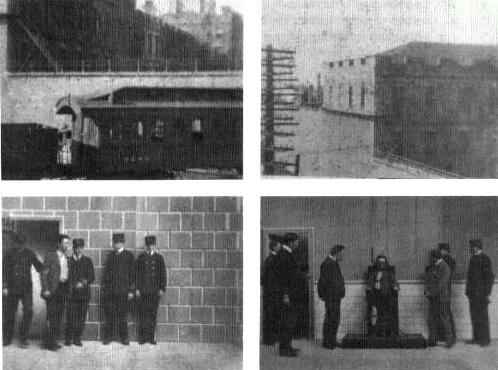
Execution of Czolgosz.
Although Execution of Czolgosz, with Panorama of Auburn Prison contains only four shots and "three scenes," the resulting film has a surprisingly sophisticated structure. According to the Edison catalog:
The picture is in three scenes. First: Panoramic view of Auburn Prison taken the morning of the electrocution. The picture then dissolves into the corridor of murderer's row. The keepers are seen taking Czolgosz from his cell to the death chamber. The scene next dissolves into the death chamber, and shows State Electrician, Wardens and Doctors making final test of the chair. Czolgosz is then brought in by the guard and is quickly strapped into the chair. The current is turned on at a signal from the Warden, and the assassin heaves heavily as though the straps would break. He drops prone after the current is turned off. The doctors examine the body and report to the Warden that he is dead, and he in turn officially announces the death to the witnesses. 200 ft.[86]
The film's longer, copyright title acknowledges that it is a hybrid that combined two genres: the panorama and the dramatic reenactmerit. An exhibitor could buy the narrative portion with or without the opening panoramas. Thus the editorial decision of the producers could be disregarded if the exhibitor so de-
sired. The film, however, was not simply two separate subjects held together by a dissolve and a common theme: it also made use of a spatial, exterior/interior relation between shots that was beginning to be employed by other filmmakers.[87] The dissolve between the first two scenes not only linked outside and inside, but actuality and reenactment, description and narrative, a moving and a static camera.
The panoramas at the beginning provide the narrative with a context, a well-constructed world in which the action can unfold. Photographed on the day of the execution, the first shot pans with a train as it approaches the prison and then reveals an empty passenger car.[88] It was such a car that brought the witnesses to the prison and led to the final stages of the execution.[89] The second shot shows a more foreboding portion of the facade. These shots distinguish this reenactment film from its contemporaries by heightening the realism. At the same time, they are part of a drama that leads the audience step by step to a vicarious confrontation with the electric chair and a man's death.
The temporal/spatial relation between the second and third scenes is more complex than a casual viewing would suggest. For a modern audience, schooled in the strategies of classical cinema, the pause before Czolgosz's entrance in the last scene facilitates the illusion of linear continuity by allowing time for the prisoner to move from one part of the prison to another. The New York Times noted, however, that "Czolgosz was confined in the cell nearest to the death chamber, so that when he entered the execution room this morning he had only to step a few feet through the stone arch."[90] This spatial relation between the two rooms was known by Edison personnel and most spectators: it suggests the kind of temporal overlap occasionally found in theater. The narrative event was not structured like the descriptions in the New York Times and New York Journal . These started with (1) the activities in the death chamber prior to Warden Mead's signal to have the prisoner brought in—including the testing of the chair, (2) then moved to Czolgosz's cell and his march down the corridor, and (3) shifted back to the death chamber with a description of the execution. The Times maintained a rigorous chronological account of events, while moving freely from a description of activities in one space to activities in another. Porter, in contrast, maintained individual scenes intact by manipulating early cinema's flexible pro-filmic temporality.
Execution of Czolgosz is remarkable for its control of pro-filmic elements. There is a purposeful elaboration of plot in the dramatic portion of the film: Czolgosz is not simply led off and executed. At the beginning of the second scene, the prisoner is at the doorway of his cell. After a few moments, the guards enter from the right, and he withdraws from the doorway. The guards open the cell door, go in and bring him out. He is brought from his cell reluctantly but without resistance. Acting and gesture are restrained, motivated by the desire to reenact the execution in as realistic a manner as possible, in marked contrast to Porter's comedies, which were indebted to burlesque and the comic strip. De-
viations from the norms of classical cinema in acting style and schematic set construction have sometimes been attributed to the naivete of early cinema, a lack of control over pro-filmic elements and insensitivity to "the demands of the medium." In Execution of Czolgosz , control and sensitivity are not the issues. This affirms the fact that Porter's comedies were "crude" because he was working within a genre where crudity was expected—burlesque and realism being fundamentally at cross-purposes. Yet despite the reliance on reenactment in Execution of Czolgosz , the two interior scenes are photographed against sets that show a single wall running perpendicular to the axis of the camera lens. As with The Finish of Bridget McKeen , the images lack almost all suggestion of depth—flattened not only by the sets but by the actors, who move parallel to the walls.
Edison's Conservative Business Strategy
From mid July 1901 to mid March 1902, a period of eight months, the Edison Manufacturing Company had a virtual monopoly in film production and sales within the United States. Rather than anticipating a possible reversal in the higher courts and parlaying this potentially short-term legal windfall into a long-term business advantage, Gilmore and White pursued a conservative, shortsighted business policy. Rather than investing in expensive productions that might yield lasting benefits, they produced inexpensive actualities and duped European spectacles to avoid high negative costs. Thomas Edison needed money for his other business schemes and was clearly unwilling to allocate funds for the Kinetograph Department. As he wrote in mid December 1901, "I am putting all my ducats in the storage battery."[91] Underfinanced, the Edison Company directed revenues toward attorney fees rather than into uncertain production ventures.
While producing McKinley films, Porter paused to photograph the America's Cup races off Sandy Hook in late September and early October, including "Columbia" and "Shamrock II," Start of Second Race , and Panoramic View of the Fleet After Yacht Race . This group of eight short films was also offered to exhibitors as a complete set, with dissolving effects melding them into a single program totaling 775 feet.[92]
During this period, filling special orders was an important part of the Kinetograph Department's business. James White later explained that the Edison Company "took pictures for people at special prices per foot for the negative and a special price per foot for the positive printed therefrom. These negative films remained in possession of the Edison Manufacturing Company but were the property of the people for whom they were exposed. The positive films were issued from them only on written order and in accordance with the price agreed upon at the time the negatives were taken."[93] Since the resulting pictures were neither copyrighted nor entered into Edison catalogs, the full dimensions of these activities remain unknown. However, in early November, White took a
moving picture from the rear end of a train "to be used by 'Dare Devil' Schreyer in his sensational 'mile-a-minute ride behind a train' on the stage of Keith's Theatre, New York."[94] Many orders were made by or executed through the rapidly growing Kinetograph Company with the help of silent partners White and Schermerhorn. In October 1901 "the largest contract ever known in the moving picture business" had the Kinetograph Company exhibiting special films for Mayor Richard Crocker's reelection campaign. Projected images played prominent roles on both sides as Seth Low's Fusion ticket fought Crocker's Tammany Hall gang.[95] A typical Kinetograph Company exhibition occurred on a large canvas covering the front of a saloon run by James J. Dowling, brother of the local Democratic district leader. One selection was "a cartoon representing Seth Low standing in a waste[basket] and showered with Tammany votes."[96] As several hundred people watched, the machine burst into flames, terminating the exhibition—an appropriate denouement, for Low was soon victorious. Afterwards Waters offered to sell fifty projecting machines "which have been used less than one month; complete and guaranteed in every part."[97]
Soon after the Crocker contract, the Kinetograph Company engaged White to film The Jeffries and Ruhlin Sparring Contest at San Francisco, Cal., November 15, 1901 and undoubtedly hoped the results could be toured like The Corbett-Fitzsimmons Fight or The Jeffries-Sharkey Fight . White's expenses for taking the pictures totaled $457.[98] Although the Edison manager later claimed to have traveled across the country alone, the inactivity of the Edison studio during November and December suggests that Porter may have accompanied him. Certainly Porter's experience as an electrician would have been valuable in lighting the indoor event, a difficult task, at which the Vitagraph and Edison companies had failed two years earlier.[99] Immediately before the fight,
The attendants began to stretch new canvas on the ring and a dozen men with ladders and a whole tool shop began to pull and haul at a great square of boards and canvas that hung over the squared circle. It was the kinetoscope apparatus, eighty powerful arc lights and four Navy searchlights. For ten minutes the electricians swung through the rafters getting everything in readiness. On the Grove street side of the Pavillion a temporary booth with glaring red peep holes held the business part of the machine.[100]
These powerful lights produced extreme heat, which the combatants felt from the very beginning.[101] The fight only lasted five rounds, limiting the film's commercial usefulness. As White later recalled, "the pictures were not long enough in themselves to form a complete exhibition, and therefore they had to be put in vaudeville as a short act. A bull fight would be, I think, fifteen or twenty rounds. The film I took would take about twenty minutes to exhibit at the usual rate of speed."[102] After selling a copy of the fight film to someone on the West Coast, the Edison Company assumed ownership of the subject and credited Waters' account. The sales price on this subject was raised to 25¢ a foot, with
the added fee serving as a royalty and presumably going to the fighters.[103] The Kinetograph Company still showed the fight film at Miner's Eighth Avenue Theater during the first two weeks of December; it was then copyrighted and offered for sale to the general public.[104]
The West Coast expedition turned into a reprise of White's 1897-98 tour of the West and Mexico. Soon after the fight, he was in British Columbia taking films for the Canadian Pacific Railroad (Panoramic View, Kicking Horse Canyon ). These later views of dramatic scenery were taken from the front of a moving train near Golden and Leanchoil. Back in the Bay Area, White produced numerous films for travel lectures (Fishing at Faralone Island, Chinese Shaving Scene ). He then visited Southern California (Ostrich Farms at Pasadena ) before heading south to Mexico City, where he filmed The Great Bull Fight on February 2, 1902.[105] This 1,000-foot film was sold in whatever lengths the exhibitor might desire.
During White's three-month absence, East Coast production was slight. On November 16th, an Edison cameraman shot Automobile Parade on the Coney Island Boulevard with "perhaps 100 machines in line, big and little, old and new, steam, electric and gasoline."[106] The parade, sponsored by the Long Island Automobile Club, was part of the preliminaries to a series of races in which Frenchman Henri Fourier, "the King of Chauffeurs," drove a "lightning mile" in 51 4/5 seconds. These races, which made the front page of New York papers, were delayed, and lack of light probably prevented them from being successfully kinetographed. The new year began with the filming of the Mummers Parade in Philadelphia. James Smith may have been responsible for both productions.
With few new studio productions to sell, the Edison Company used its legal position to acquire original negatives from former competitors. A group of Vitagraph subjects from 1900 were acquired and copyrighted in Edison's name in mid December. These included The Mysterious Care, Harry Tompson's Imitations of Sousa, Roeher Wrestling Match, The Artist's Dilemma , and The Fat and Lean Wrestling Match . Edison's sales listings were also enhanced by "dupes." Méliès' Little Red Riding Hood and other Houdin trick films were added to the Edison catalog in the later part of 1901.
Production at the Edison studio resumed in January 1902, coinciding with Porter's increase in salary to $20 a week. From this point forward, the former exhibitor turned cameraman assumed firmer control over studio production. While collaborations with George Fleming and others continued, Porter was at the center of these activities. This new situation began with a series of trick films, some of which were remakes of foreign subjects.[107] In Uncle Josh at the Moving Picture Show , a rube confuses the projected image with real life and, trying to interfere with events shown on the screen, disrupts the show. Though this gag was as old as projected moving pictures, Porter's comedy was indebted to an earlier film by Robert Paul, The Countryman's First Sight of the Animated Pictures .[108] Porter's remake substituted Edison scenes and titles for the films
within the film. Since the comedy's production required mattes and optical reduction, it posed a technical challenge Porter must have found intriguing. The Twentieth Century Tramp; or, Happy Hooligan and His Airship was indebted to Ferdinand Zecca's A la conquête de l'air .[109] It used a split screen image: the top half showed a tramp on a bicycle pedaling his balloon-airship against a plain background, while the bottom half is a "circular panorama" of the city. In the pre-cinema lantern world, such images had been achieved by the use of multiple projections, allowing each slide—each part of the image on the screen—to unfold independently in time. It is easy to conceive of a lantern show similar to The Twentieth Century Tramp , in which a mechanical slide of a tramp was projected onto the top half of the screen and a moving panorama on the bottom. Practically, the new technology of moving pictures required that such composites be executed on the film rather than on the screen, and they were one element in the gradual consolidation of creativity within the production company.
Upon his return to New York, manager James White spurred East Coast production, revitalizing the concept of cinema as a visual newspaper. Edison personnel photographed Paterson, New Jersey, shortly after its devastating fire on February 9th (Panorama of the Paterson Fire ). Cameramen had arrived too late to shoot any actual firefighting. As a result, the films emphasized spectacle and landscape, displaying the devastation with sweeping panoramas. No effort was made to show how the fire affected people's lives. On February 15th The Burning of Durland's Riding Academy was taken at Central Park West between Sixty-first and Sixty-second streets in New York City. The panning camera captured firemen hosing down the still smoldering remains. Since the film was only of local importance, it was renamed Firemen Fighting the Flames at Paterson and sold as footage of the better-known event. Relabeling films to increase their commercial potential was neither unusual nor "naive" but consistent with the highly opportunistic business ethics of Edison and other film producers.
On February 17th, the Kinetograph Department photographed New York City in a Blizzard .[110] Immediately after the snowfall, Porter and his associates made Capture of the Biddle Brothers , reenacting the sensational shoot-out between the Biddle brothers and law officers. This one-shot film of a newsworthy event was executed in the cool, controlled style of Execution of Czolgosz . The Edison catalog informed potential purchasers:
CAPTURE OF THE BIDDLE BROS.
The public throughout the world is acquainted with the sensational capture of the Biddle Brothers and Mrs. Soffel, who, through the aid of Mrs. Soffel, escaped from the Pittsburg jail on January 30th, 1902. Our picture, which is a perfect reproduction of the capture, is realistic and exciting. It shows the sheriffs in two sleighs coming down the hill on the snow covered road. Mrs. Soffel and the Biddle Brothers appear in the foreground going toward the sheriffs. Immediately the sheriffs are seen by Ed. Biddle, he stops the sleigh, and rising, begins firing at the sheriffs with a shotgun. He is the first to be shot and falls to the ground in a snow bank, but, game to the last, he rises
on one elbow and fires shot after shot with his revolver. Mrs. Soffel and the second Biddle then begin firing. When Mrs. Soffel sees that their capture is certain, she attempts to take her own life by shooting herself with the pistol. The sheriffs are finally victorious and the two convicts with the unfortunate woman are loaded into the sheriffs' double sleigh. Class A. 125 ft.[111]
In late February and early March, the Kinetograph Department filmed Prince Henry of Prussia's visit to the United States. Edison cameramen photographed the royal visitor's arrival in New York City and followed him to Cambridge, Massachusetts, where the prince met the German-American psychologist and philosopher Hugo Münsterberg at Harvard. Porter was even sent to Chicago to photograph Prince Henry at Lincoln's Monument, Chicago, Illinois .[112] The most noteworthy films were of the christening of Kaiser Wilhelm's yacht Meteor at Shooter's Island, taken on February 25, 1902. In this last situation, Edwin Porter and Jacob Smith filmed the Meteor entering the water simultaneously from their two different camera positions. When these two films, Christening and Launching Kaiser Wilhelm's Yacht "Meteor " and Kaiser Wilhelm's Yacht "Meteor" Entering the Water were shown together, what had been filmed simultaneously was shown successively. Exhibitors could present the same event from two different points of view, offering their patrons a double perspective that might be described as a novelty.
Edison films taken in the winter of 1901-2 were principally actuality subjects. Like Cutting and Canaling Ice , taken in Groton, Massachusetts, most consisted of several shots taken at approximately the same time and place. These single, but elaborated, scenes were still small enough for showmen to incorporate into larger sequences, but allowed the producer to perform an editorial function as well. The few studio films made in early 1902 included Facial Expression , which showed "one of the most talented lady facial expression artists in the world, executing the most amusing facial gyrations."[113] Two others of the same genre followed. Burlesque Suicide, No. 1 and Burlesque Suicide, No. 2 were medium shots of a despairing man putting a gun to his head. In one version he takes a drink instead of pulling the trigger; in the other he points his finger at the camera and laughs.[114]
While comedies and fairy-tale films were popular with audiences, the lack of competition meant that the Kinetograph Department did not have to cater extensively to this demand. Many could be imported and duped. Edison's New York studio was used less during the winter of 1901-2 than when it first opened. Unnecessary expenses (actors' salaries, sets, etc.) could thus be avoided. The shift toward story films then taking place in Europe was delayed in the United States by legal and business factors.
William Paley, who remained an Edison licensee into 1902, continued to take actualities that ended up in the Edison catalog. Montreal Fire Department on Runners , taken in March 1901 for the opening of a Proctor theater in that city, showed a fire run that demonstrated the Canadians' use of sleighs for
firefighting purposes. Two months later, Paley took local views of the trolley car strike in Albany, New York. These, too, were shown in the local Proctor theater. "Paley's kalatechnoscope will blossom out this week by displaying several moving pictures incidental to the big trolley car strike of last week," reported the Albany Evening Journal . "A picture of the Third Signal Corps escorting the repair wagon down State street will be shown, also the first car that was run down State street with militiamen as passengers, besides other interesting incidents."[115] These were greeted by loud rounds of applause from the predominantly anti-union audience at Proctor's and then offered for sale as The Great Albany Car Strike .[116] Paley took more films in or near Montreal during 1902. These included Skiing in Montreal (© February 10, 1902), Coasting Scene at Montmorency Falls, Canada , and Arrival of the Governor General, Lord Minto, at Quebec (© February 17, 1902).[117] These served as a modest supplement to Edison's own output.
Histories of early cinema often refer to a decline in the popularity of moving pictures around the turn of the century, particularly in vaudeville theaters, where motion pictures were the last act on the bill and large portions of the audience left when the films were shown. These programs were often known as "chasers," and for this reason these years have often been called "the chaser period." Disfavor has generally been attributed to a jaded audience tiring of actuality scenes and news footage. Although at least one recent historian has dismissed this as a myth perpetuated by gullible scholars, data from different branches of the film industry indicate that cinema did experience a period of retrenchment and even contraction early in the twentieth century.[118] The Edison Company's near monopoly contributed to these difficulties. The Kinetograph Department would have had to expand its production levels rapidly if other branches of the industry were to have remained unaffected by the court decision. Instead, as the preceding section has shown, the Edison corporation pursued a self-serving business policy. As one might expect, Edison film sales (and profits) increased significantly during the 1901-2 business year-roughly 68 percent, from $49,756 to $82,108. This increase, however, was not equivalent to the sales lost by the inventor's competitors. Sales of projecting kinetoscopes, moreover, remained the same as the year before the Edison monopoly.
While Edison's legal actions contributed to difficulties in the motion picture industry, evidence also suggests that the concept of cinema as a visual newspaper needed to be rethought. Actuality subjects were losing much of their appeal. As long as the Edison Manufacturing Company was the only American business selling news films, this decline was not an immediate problem, since it controlled the entire market. Only when Edison's competitors reentered the moving picture field in the spring of 1902 did the Kinetograph Department have to rethink its production patterns.
Defeated in the Courts, Edison Faces Renewed Competition
The circuit court decision upholding Edison's patents was reversed on March 10, 1902, by the court of appeals. The lower court was instructed to dismiss the bill of complaint against Biograph with costs. In his closely analyzed opinion, Judge William James Wallace wrote:
It is obvious that Mr. Edison was not a pioneer, in the large sense of the term, or in the more limited sense in which he would have been if he had also invented the film. He was not the inventor of the film. He was not the first inventor of apparatus capable of producing suitable negatives, taken from practically a single point of view, in single-line sequence, upon a film like his, and embodying the same general means of rotating drums and shutters for bringing the sensitized surface across the lens, and exposing successive portions of it in rapid succession. Du Cos anticipated him in this, notwithstanding he did not use the film. Neither was he the first inventor of an apparatus capable of producing suitable negatives, and embodying means for passing a sensitized surface across a single-lens camera at a high rate of speed, and with an intermittent motion, and for exposing successive portions of the surfaces during the periods of rest. His claim for such an apparatus was rejected by the patent office, and he acquiesced in its rejection. He was anticipated in this by Marey, and Marey also anticipated him in photographing successive positions of the object in motion from the same point of view.
The predecessors of Edison invented apparatus, during a period of transition from plates to flexible paper film, and from paper film to celluloid film, which was capable of producing negatives suitable for reproduction in exhibiting machines. No new principle was to be discovered, or essentially new form of machine invented, in order to make the improved photographic material available for that purpose. The early inventors had felt the need of such material, but, in the absence of its supply, had either contented themselves with such measure of practical success as was possible, or had allowed their plans to remain upon paper as indications of the forms of mechanical and optical apparatus which might be used when suitable photographic surfaces became available. They had not perfected the details of apparatus especially adapted for the employment of the film of the patent, and to do this required but a moderate amount of mechanical ingenuity. Undoubtedly Mr. Edison, by utilizing this film and perfecting the first apparatus for using it, met all the conditions necessary for commercial success. This, however, did not entitle him, under the patent laws, to a monopoly of all camera apparatus capable of utilizing the film. Nor did it entitle him to a monopoly of all apparatus employing a single camera.[119]
Edison's patents were rejected, and the inventor had to seek patent reissues with new, narrower claims.
Biograph revived its business and began to merchandise Warwick films, duped Méliès subjects, and 35mm reduction prints of its own large format films.[120] Biograph thus had a two-pronged business strategy, in which the company produced pictures exclusively for its own exhibition circuit, but eventually sold the subjects after their "first-run" potential was exhausted. As we have
seen, this approach was similar to Vitagraph's during the 1890s. The transition to 35mm films was difficult for Biograph and took over a year to complete. Company executives initially straddled the problem by offering two services: the old, 70mm Biograph service and the new, 35mm "Biographet" service.[121] The large-gauge projectors at Keith theaters could only show Biograph's own productions. The 35mm service used imported films, but did not receive sufficient attention to make it fully competitive with Vitagraph or the Kinetograph Company. Biograph was hampered by the technological incompatibility of its two services.
Judge Wallace's decision freed all American film producers from immediate legal constraints. Vitagraph resumed the production of news topicals and other subjects for use on its expanding exhibition circuit. Chicago producer William Selig, who had remained relatively unaffected by the eastern court battles, resumed advertising in the New York Clipper .[122] Sigmund Lubin returned from Europe and reactivated his business. He not only resumed production but sold duplicate copies of copyrighted Edison productions, notably those of Prince Henry's American tour. In a quid pro quo, Lubin was disrupting Edison's business just as Edison had disrupted his. The "Wizard" promptly challenged Lubin with a lawsuit, but was denied a preliminary injunction, leaving the Philadelphia optician free to pursue these activities while the case worked its way through the courts.[123]
Renewed competition forced the Kinetograph Department to reassess its business policy. In some areas, Gilmore and White refused to change. With Lubin consistently underselling Edison's rate of fifteen cents per foot for prints by three cents, Gilmore did what he had done with the National Phonograph Company. He refused to lower prices and insisted that Edison's product was the standard against which all competitors should be judged:
SPECIAL NOTICE TO EXHIBITORS
We have no cheap films to offer, but we will give you the finest subjects procurable at a fair price; films that are worth owning and that will cultivate the public's taste for motion picture shows instead of disgusting them.[124]
The Edison Company also announced an increase in the size of its photographic staff and the number of picture-taking operators.[125] By midsummer it was employing three active photographers. In the United States, Porter remained based in the New York studio and also took some actualities, while J. Blair Smith traveled along the East Coast taking news and travel films. In Europe, the Lebanese-American cameraman Alfred C. Abadie was responsible for supplying the Kinetograph Department with his own original subjects as well as prints of the best European releases. In addition, James White and one or two others occasionally photographed new subjects.
White left for Europe in April to arrange for the importation of film subjects and to photograph the coronation of Edward VII.[126] Although the crowning
was postponed owing to Edward's poor health, the department manager was able to shoot films of his trip. Among those copyrighted and offered for sale in June were The S.S. "Deutschland" Leaving the Dock in Hoboken, The S.S. "Deutschland" in a Storm, No. 1 and Shuffleboard on S.S. "Deutschland. " White may have been accompanied by Abadie, who then remained in Europe to represent Edison's interests. By August, Abadie was sending back coronation films to be duped at West Orange. One of these was hand-carried by Edison lawyer Howard Hayes. On shipboard, Hayes sent notice of his imminent arrival:
U.S.M.S. "Philadelphia"
Friday, August 22, 1902
My dear Gilmore:
We get in early tomorrow morning, probably about 9 o'clock. I will telegraph you to that effect from quarantine where we are due about mid-night. I have a new film of the coronation taken by another company which Abadie gave me to give to White for him to "dub." I shall get to my house not later than noon, so if no one comes to the wharf for it you had better send a messenger to my house for it any time after twelve. The negative of the coronation Naval Review will arrive about next Wednesday. Abadie [said] he could not get them off earlier than Wednesday the 20th . . . . [127]
The timely importation of English and French subjects would continue to concern Gilmore and White for the next several years. Edison was increasing its duping of foreign films for the American market and attempting to acquire these before Biograph, Vitagraph, or Lubin.
While actualities and short comedies still provided Edison with the bulk of its original productions, longer studio-made films began to play a key role as the company sought to maintain commercial dominance. This development, which put new emphasis on the studio where Porter was in charge, was reflected in the production of four "story" films: Appointment by Telephone (© May 2, 1902), Jack and the Beanstalk (© June 20, 1902), How They Do Things on the Bowery (© October 31, 1902), and Life of an American Fireman (© January 21, 1903).
Appointment by Telephone is a simple, three-shot comedy in which Porter achieved a smooth narrative progression from one scene to the next.[128]
APPOINTMENT BY TELEPHONE
Two young men are seated in a broker's office. A young lady calls one of them on the telephone and makes an appointment to meet him at a certain restaurant. The scene dissolves to the outside of a restaurant, and the young man appears waiting for the young lady, who soon comes along and they go inside. The scene dissolves again and shows the interior of the restaurant and the young couple coming in and taking their seats at a table next to the window. The young man's wife happens to pass the window just as they get seated, and looking in recognizes him. She confronts the pair in the restaurant in a state of great anger just as the waiter is serving champagne; then the trouble begins. The table and chairs are wrecked, and the husband and young lady
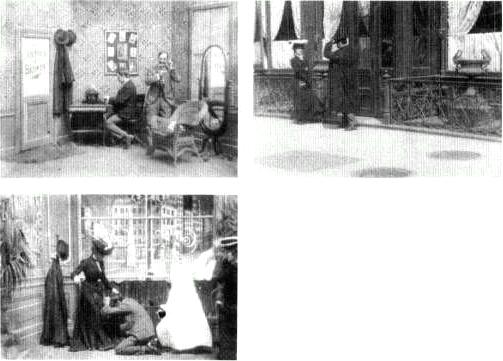
Appointment by Telephone.
are severely horsewhipped by the enraged wife. A very fine photograph, full of action from start to finish, and a subject that will appeal to everyone. 100 ft.[129]
It was a remake of a two-part Edison subject from 1896:
AN APPOINTMENT BY TELEPHONE—First Scene—
A gay young man in a Wall Street broker's office, with wicked intentions makes an engagement with a pretty typewriter. The sequel brings about his discomforture and the triumph of the typewriter.
SUPPER INTERRUPTED—Second Film—
The gay young man with the wicked intentions, from his Wall Street broker's office, hies himself to the place of appointment and meets the pretty typewriter. Just as they are sitting down to supper his irate wife appears upon the scene and there is a denouement. The wicked young man is exposed and disgraced by his wife's explanation.[130]
Not only was the 1902 remake sold as a single subject, but Porter added another shot, taken outside the restaurant. The three-shot film isolates a beginning (the
appointment), a middle (the meeting), and an end (the confrontation with the wife). The second shot establishes the space from which the wife spies her husband's infidelities. The film employs not only an exterior/interior spatial relationship between shots 2 and 3 but a reverse angle to show overlapping space. This construction of a fictional world is achieved as the young man and his female companion exit in shot 2 and enter in shot 3 and is reinforced by the movement of the wife from the sidewalk to the interior of the restaurant in the final scene. Temporal continuity is established between these two shots, although it remains imprecise: the set in the third shot is constructed and filmed in such a way that even the possibility of matching action is excluded. Unlike earlier Edison films, the sets have corners and additional walls: they are no longer simple flats erected parallel to the camera. The elaboration of space both in terms of editorial strategy and set construction occurs simultaneously.
Appointment by Telephone can be seen as a sketch, an experiment in cinematic representation, which Porter immediately employed in Jack and the Beanstalk , a ten-shot narrative more than twice the length of any previous studio-made film. Porter was assisted by James White's brother, Arthur.[131] "It was a matter of great difficulty, and required great artistic skill to arrange all the different scenes, pose the various subjects and take the views successfully," claimed Porter in a deposition. "It took in the neighborhood of six weeks in the spring of 1902 to successfully make this photograph."[132]
Fairy tales had gripped the romantic imagination at the beginning of the nineteenth century, providing a vision that combined innocence, myth, and age-old tradition, which were rapidly being undermined by a capitalist economy. They lent themselves to either radical interpretations of a lost equality and harmonious past, or conservative memories of contentment, ignorance, and piety on the part of the folk.[133] Porter, however, turned to a version of Jack and the Beanstalk that had been bowdlerized so as to provide a moral justification for Jack's robbing of the giant. The result, in the words of Bruno Bettelheim, makes the film "a moral tale of retribution rather than a story of manhood achieved."[134]
By the end of the century, fairy tales had been largely relegated to children, who were entertained and socialized by such lantern shows as Cinderella, Robinson Crusoe, Bluebeard, Gulliver's Travels , and Jack and the Beanstalk . These subjects briefly regained an adult audience as Georges Méliès and G. A. Smith revitalized this screen staple, making fairy-tale films an important genre of early cinema. The theatrical tradition of pantomimes, which generally used fairy tales as a narrative premise, also provided an important model for films of this genre, particularly in respect to acting style. (But less often a narrative model. Pantomimes customarily sacrificed narrative for spectacle. With the exception of Méliès' Cinderella , these films seem consistent with the narrative elaboration found in lantern shows.) To cite merely one instance of stage and lantern show traditions converging in cinema, the depiction of dreams and vi-
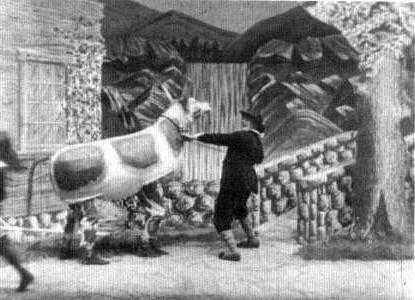
Jack and the Beanstalk. Scene 1: Jack departs after having sold the cow for a hat full of beans.
sions in Jack and the Beanstalk was done using devices common to both media. The extremely close interrelationship between theater and screen is particularly apparent in Jack and the Beanstalk .
Jack and the Beanstalk is ignored by Terry Ramsaye and Lewis Jacobs, no doubt because its subject matter and techniques are indebted to Méliès (particularly Bluebeard , 1901), suggesting that Porter was an imitator rather than an originator. This quiet dismissal does the film a disservice, for it contains all the elements that historian A. Nicholas Vardac sees in Life of an American Fireman : the pictorial development of two lines of action, spectacular devices such as the vision that introduces the second line of action, dissolves between scenes, and a change in camera position showing interior and exterior as the action moves from one space to the next.[135] The cinematic innovations cited by Vardac had become common techniques and strategies for filmmakers by 1901 and can be found much earlier in lantern shows.
Porter's first use of an increasingly elaborate and integrated narrative can be located in May and June 1902. Obviously this does not mean that Appointment by Telephone and Jack and the Beanstalk were among the first narrative films. With earlier subjects, however, individual scenes had functioned as self-contained units that could be selected and organized at the discretion of the exhibitor, who thus maintained a fundamental relationship to the narrative as
it was constructed and projected on the screen. In films like Jack and the Beanstalk , the exhibitor's role was reduced to one of secondary elaboration. Dissolves had given the production company a degree of editorial control, and the simple progression of a story from shot to shot tended to concentrate creative contributions in the hands of the producer. What is under consideration, then, is a shift in the character and function of the narrative, not its first application to either cinema or the screen. Under these new circumstances the exhibitor was increasingly reduced to the role of programmer and narrator.
The catalog description for Jack and the Beanstalk (see document no. 8) had a dual purpose: to sell the film and provide material for a potential lecturer. Although "every scene [was] posed with a view to following as closely as possible the accepted version of Jack and the Beanstalk, " an exhibitor's running commentary could clarify the story line, add characterization, and enrich the film's psychological dimension. The benefits derived from such an intervention are readily apparent after checking this description against a silent viewing of the film. It assigns a narrative significance to the last tableau that it otherwise lacks. In scene 5 Jack's conflict between obeying his mother and following the dictates of his dream is played up in the description. Likewise the fairy's revelation that the giant killed and robbed Jack's father must either be conveyed as part of a narration or assumed to be part of the audience's previous knowledge.
DOCUMENT NO . 8 |
Jack and the Beanstalk |
SCENE 1.—TRADING THE COW. |
Jack's mother, being very poor, has dispatched him to the market to sell her only cow that they may not starve. The good fairy meets the village butcher at the bridge and informs him that Jack will pass that way with a cow which he can doubtless purchase for a hatful of beans, Jack being a very careless and foolish lad. The fairy vanishes, and Jack appears upon the scene leading the cow. The bargain is struck, and Jack runs away to show his mother what he considers a very gratifying price for their beautiful animal. |
SCENE 2.—JACK RETURNS WITH THE BEANS. |
Shows Jack's return to his mother's cottage, bringing the beans in his hat, and showing them to her in great glee, his mother's disappointment and scolding, which ends in Jack being sent supperless to bed, and the mother throwing the beans in the garden in great anger. |
SCENE 3.—GROWING OF THE BEANSTALK. |
A night scene in the garden, with beautiful moonlight and cloud effects. The good fairy appears, and waving her magic wand, commands the |
(Text box continued on next page)
beanstalk to grow; and, lo and behold, from the hatful of beans that has been so ruthlessly thrown into the garden, a beanstalk of great size is seen to grow in a few moments, and to climb up the cliff above the clouds. |
SCENE 4.—JACK'S DREAM. |
Showing the interior of Jack's bedroom with the moonlight streaming through the window. The good fairy appears and stands beside Jack's cot directing his dream. Jack dreams of the growing beanstalk and the award that awaits him who dares to climb it. Next he sees a vision of the Horn of Plenty, bags of the giant's gold and the talking harp, which dances before him in a weird manner. One by one these articles appear and disappear in the picture, coming as if from the dim distance, and as quickly and silently fading away. The climax of this scene is reached when the hen which lays the golden eggs walks into Jack's chamber. An egg is left on the floor, which suddenly grows to an enormous size, breaks in two, and there appears in its centre Jack's little fairy, who is afterward to make him happy for life. |
SCENE 5.—CLIMBING THE BEANSTALK. |
Jack awakes in the early morning, and looking out from his window, finds the enormous beanstalk which has grown above the clouds. Remembering his dream of the night before, he believes he can climb it with ease; but also remembering his mother's scolding for trading the cow for the beans, he is prompted to be cautious, and concludes to consult his mother. She protests vigorously against his climbing the beanstalk, but Jack sending her into the house on a pretext, starts up the beanstalk without her knowledge. The mother returns and is frantic when she finds Jack has gone up beyond her reach. She scolds and commands him to return, but the dauntless boy only laughs and continues to climb. His playmates, who are calling for Jack on their way to school, witness Jack's start on his perilous journey, and joining hands, they dance about the beanstalk in great numbers, cheering and waving their hats at the brave boy. |
SCENE 6.—JACK ABOVE THE CLOUDS. |
Here we dissolve the view and show Jack two-thirds up the beanstalk, far above the clouds, with his mother's cottage and the hilltops a great distance below him. He is still tirelessly climbing his ladder of bean vines, and pauses as he reaches a dizzy height to wave his hat to his playmates and mother. |
SCENE 7.—ARRIVAL AT THE TOP OF THE BEANSTALK. |
Jack arrives at the top of the beanstalk in what appears to be a fairyland. He is very tired and sleepy and lays down in a bed of moss to rest. |
(Text box continued on next page)
He soon falls asleep, and his good fairy again appears and tells Jack the story of the giant, who, many years ago, killed and robbed his father (who was a knight residing in a castle), and drove his mother from their home. She then causes a vision of the giant's castle to appear before Jack, and commands him to go to the giant's house where great fortunes await him. Jack's enthusiasm is fired by the story of his father's wrongs, and he immediately sets out to obey the commands of the fairy. |
SCENE 8.—THE GIANT'S KITCHEN. |
Shows Jack's arrival at the giant's house, and being admitted to the kitchen by the giant's wife. The giant suddenly enters, and in great fear lest he kill and eat the little boy, the good wife hides Jack in a large kettle. The giant comes in and roughly demands his supper, then his harp, bags of gold and the hen which lays the golden eggs. He finally falls asleep from the playing of the harp. Jack creeps from his hiding place in the kettle and steals the hen and as many of the bags of gold as he can carry away. Just as he leaves the kitchen door the giant awakens, and, seizing his great cudgel, chases our little hero, who is now thoroughly frightened. |
SCENE 9.—JACK DESCENDING THE BEANSTALK AND DEATH OF THE GIANT. |
The chase to the beanstalk has been very close, but Jack reaches it a little ahead of the giant. He throws the bags of gold down into his mother's garden and quickly scrambles down with the precious hen hanging over his shoulder. Reaching the ground first, he hastily commands his mother to bring him the ax, and vigorously chops at the beanstalk until it falls in a heap, bringing the giant to the ground with a mighty crash, breaking his neck and instantly killing him. Here the good fairy again appears and informs Jack that he has acted like a brave knight's son and that he deserves to have his inheritance restored to him. She waves her magic wand, and, lo! Jack's costume is changed from that of a peasant boy to a young knight, and his mother is likewise transformed from a peasant woman to a lady. |
CLOSING TABLEAU. |
A most beautiful scene, showing Jack and his mother seated in the fairy's boat, which is drawn by three beautiful swans, proceeding on their way to the castle which is to be their future home. The good fairy is seen to be flying through the air, guiding Jack and his mother on their way. |
In introducing this novel tableau, giving as it were an entirely new version to the ending of the story, we believe we are adding a feature which will be most pleasing to every child who witnesses the performance. It is certainly most gratifying and comprehensive, and will at once be recognized as the beginning of the journey to the castle which, in accor- |
(Text box continued on next page)
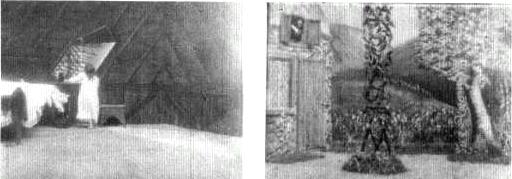
Jack and the Beanstalk. The cut from interior (end of scene 4) to exterior (beginning of scene 5) is not a match cut.
dance with the good fairy's promise of the reward to him who dares to climb the beanstalk, she is restoring to Jack and his mother. |
Sold in complete length only. Class A. 625ft. |
SOURCE : Edison Films , September 1902, pp. 116-17. |
Since the film was designed so that "the audience finds itself following with ease the thread of this most wonderful of all fairy tales," the showman's spiel remained optional. If the exhibitor so wished, he could let his patrons rely on their own familiarity with the story, since it "is known to every child throughout the civilized world" and "appeals to every man and woman because they remember it as one of the most pleasant illusions of their childhood."[136] A lecture, however, enabled the exhibitor to make his own creative contribution to the cinematic story. Jack and the Beanstalk only lacks an adequate cinematic language if the film is expected to act as a self-sufficient narrative—a misreading of its institutional context.
Intimately tied to the development of a more elaborate narrative was the creation of a fictional world with spatial and temporal relations between scenes. With scenes 3, 4, and 5, Porter cuts freely from the cottage exterior to the interior of Jack's room and back to the exterior. Scenes 5, 6, 7, 8, and 9 are carefully constructed with entrances and exits, glances, set cues, and narrative continuities that give spectators information from which to deduce the approximate spatial relationships between the various shots. Temporality remains more problematic, still unspecified and at moments perhaps even confused: the cut between scenes 4 and 5, which is open to different interpretations, may serve as an example. In scene 4, after Jack ends his dream, he wakes up and walks to the window in his nightgown. Scene 5 begins with Jack at the window, but fully clothed; a moment later he disappears from view and comes out the front door. The catalog confuses the issue by inaccurately describing this portion of the film,
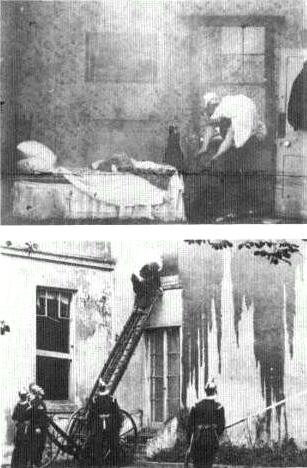
Fire! Williamson also cut from interior to exterior.
but at least two interpretations seem possible. Porter could have intended a temporal match cut on action while simply ignoring an element of continuity (clothing); or, he may have intended something we might call a temporal abridgment, although the term suggests a precise awareness of temporal continuities that the filmmaker and his audience did not enjoy. A similar cut occurs between the last two shots of James Williamson's Fire! in which the camera "follows the rescue out the window." Here the fireman is never actually shown climbing through the window as he carries the victim from the burning bedroom to safety outside. This could be seen as a match cut that is awkwardly executed or again
as a kind of temporal abridgment (excluding roughly the time it took the fireman to climb through the opening).
The problem highlighted in these two cuts is one that faced all filmmakers of this period—temporality. Whereas the spatial relations employed in lantern shows could readily be adopted by cinema, the temporal dimension was only implied with static slides, primarily via a narration. Film, which is presented unfolding in time, demonstrates a tendency to make temporal relationships explicit. Continuity of action, embryonic at best in lantern shows, likewise became a central problem for early cinema. The mechanistic prejudice of film historians in the past has been to assume that early filmmakers were attempting to match action, just doing it badly. The problem is then seen as one of execution and manipulation of pro-filmic elements. The reverse is more likely: early filmmakers like Porter and Williamson had adequate control over pro-filmic elements, but their major problem was conceptual. Across both cuts there is strong narrative continuity that is translated into something that to our modern eyes approaches a match cut: but neither Porter nor Williamson was attempting to match action between contiguous spaces.[137]
Jack and the Beanstalk was a success even before it was released. No other American production company had the resources and the ambition to make a comparable film. Edison lawyers had to make special efforts to prevent competitors from selling duped copies. This postponed its release, for Jack and the Beanstalk was advertised as completed and ready for sale in late May.[138] According to subsequent Edison announcements,
We have purposefully delayed the delivery of our great production, "Jack and the Beanstalk," until the production could be adequately protected by law, in as much as pirates have been copying our films and have been waiting until the production could be put on sail [sic ] so that they could duplicate and offer it to the public. We have taken steps to protect our film both as a theatrical production and as a picture, and the film will be ready for delivery July 15.[139]
After motions for a temporary injunction against Lubin's duping activities were denied on June 25th, the film was eventually released without any legal protection for Edison's ownership.
General Manager William Gilmore remained determined to win courtroom recognition for Edison's method of copyright. "I do not want to give up the fight if there is a possible way of getting around it," Gilmore wrote to an Edison lawyer, "as this man Lubin is continuing to duplicate films that cost us a great many hundreds of dollars to obtain and one particular film that we have just gotten out has cost us pretty near a thousand dollars to get the negative, and he simply goes ahead and copies same, making a negative and issuing positive from same indiscriminately, so you see that he is doing our business a great deal of harm and we, apparently have no redress."[140] Lubin's tactics forced the Edison
Company to adopt a new pricing system in July 1902. Class A films, usually recently copyrighted Edison productions, were sold at 15¢ per foot, while Class B subjects, mostly older Edison films and dupes, went for 12¢. Edison announced:
To counter the effect of cheap films, duplicates, worthless subjects and short length films that are being offered in the market, we are listing our genuine Edison films in two classes. Some of our subjects cost us large sums of money to obtain while others are procured at a nominal cost. Therefore the films of inexpensive subjects, we shall list as Class B at the net price of $6.00 per 50 feet.[141]
Judge Dallas's refusal to enjoin Lubin from duping virtually ended Edison's practice of submitting paper prints for copyright purposes. As a result, few films taken in the summer and fall of 1902 have survived.
After completing Jack and the Beanstalk , Porter worked on a series of short films, including imitations of popular Biograph comedies. While Biograph was showing these pictures on its programs, it was not selling them to independent exhibitors. Edison's competing versions were made available to the trade. Biograph's A Jersey Skeeter (filmed by Arthur Marvin on July 26, 1900) was reworked as Smashing a Jersey Mosquito ; its She Meets with Wife's Approval (sometimes called The New Typewriter , taken by R. K. Bonine on July 21, 1902) was redone as Smith's Wife Inspects the New Typewriter ; and Shut Up! (Bonine on August 4, 1902) became Oh! Shut Up . Porter also continued his ongoing series of tramp films with Hooligan's Fourth of July .
While Porter and Fleming were busy in the studio, J. Blair Smith was sent to Martinique, where he covered the aftermath of the Mount Pelée eruptions of May 8 and 20, 1902, which killed more than 30,000 people.[142] The Edison Company announced: "One of our special photographers was dispatched to Martinique on the first steamer sailing after this great catastrophe, and we will have the first genuine films that will be offered to the exhibitor. Do not bother with unscrupulous film makers who will offer pictures of dilapidated, blown clown buildings or some other fakes as scenes from Martinique."[143] By mid July Edison's Orange factory was selling a dozen subjects taken by Smith on his trip and three shots of a studio model of Mount Pelée in various stages of eruption, taken by Porter. The Edison catalog suggested that the combination of Porter's faked and Smith's genuine films "will make a complete show in themselves."[144]
Throughout the summer and fall, Edison photographers were busy filming news topicals, incidents of human interest, and travel scenes. One cameraman visited the summer city of Chautauqua, New York, and filmed The Annual Circus Parade on August 9th, Chautauqua Aquatic Day on August 14th, and many quotidian scenes like Swedish Gymnastics at Chautauqua, No. 8 .[145]Fat Man's Race and Sack Race were shot at an outing of St. Cecil's Lodge on Long Island. News films included C. D. Graham Swimming the Lower Rapids , taken
on August 31st, Mrs. Taylor Going over the Horseshoe Falls in a Barrel , and Trial Run of the Fastest Boat in the World, the "Arrow, " on September 6th. In Europe, A. C. Abadie was filming French Army Maneuvers, Panoramic View of the Streets of Paris , and Santos Dumont's Airship .
The largest group of films in Edison's February 1903 catalog were taken by a freelance cinematographer, perhaps Walter Parker.[146] After filming numerous scenes in the Yukon around Dawson City during the winter and spring of 1902, he worked his way down to Seattle, Washington, where he took a group of scenics. From there he traveled to Denver, Colorado, and filmed Broncho Busting Scenes, Championship of the World at the Fall Carnival on October 9 and 10, 1902.[147]
"Telling a Story in Continuity Form"
In Paris, Alfred C. Abadie attended the opening of Méliès' Le Voyage dans la lune at the Theéâtre Robert-Houdin and then quickly purchased a copy to send back to Edison for duping.[148] Since Méliès knew Edison would dupe his films and so was unwilling to make a direct sale, Abadie's purchase had to be quite devious. According to Arthur White, "through a certain Charles Gershel, a French photographer, 23 Boulevarde des Capuchines, Paris, who had a brother-in-law in Algiers, who had a theatre, Abadie was enabled to buy prints of the latest Melies pictures, among them 'The Trip to the Moon.'"[149] By the beginning of October, Edison was selling copies of Méliès' burlesque space fantasy as a Class A subject.[150] Years later Porter recalled, "From laboratory examination of some of the popular films of the French pioneer director, George Melies—trick films like 'A Trip to the Moon'—I came to the conclusion that a picture telling a story in continuity form might draw the customers back to the theatres and set to work in this direction."[151] A key moment must have been the rocket landing on the moon. One shot ends after the rocket hits the Man-in-the-Moon in the eye, making him wince. In the succeeding shot, the rocket lands on the surface of the moon and its passengers disembark. The event is seen twice from different perspectives. While Méliès' double depiction of the landing had legitimate storytelling reasons, the overlap emphasized the continuities of action and narrative from one shot to the next. It is this kind of continuity that Porter examined, conceptualized, and applied in many of his subsequent films.
How They Do Things on the Bowery could be called an experiment in editorial principles. Its simple, comic narrative had been presented in Biograph's earlier, one-shot Uncle Si's Experiences in a Concert Hall (photographed by F. S. Armitage on April 13, 1900).
HOW THEY DO THINGS ON THE BOWERY
Scene Bowery. Young woman drops her handkerchief while passing a Rube. He picks it up and gives it to her. She induces him to go into a side door of a saloon.
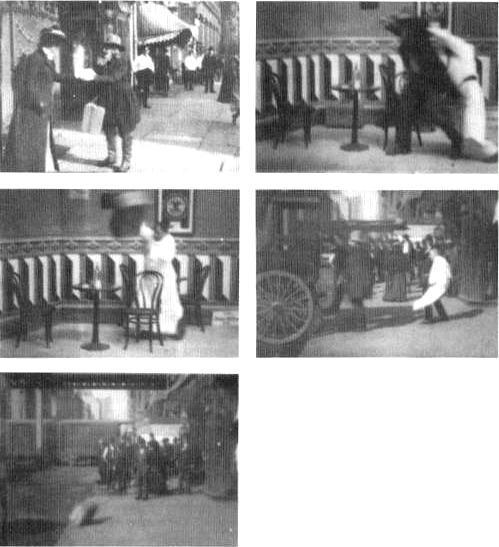
How They Do Things on the Bowery.
Second scene, saloon. Rube and woman enter, take seats at table and order drinks. While the Rube is paying for same, woman puts knock-out drops in the Rube's glass. They drink and the Rube falls asleep. Woman takes all his valuables and leaves. Waiter wakes him up. He discovers his watch gone, fights with waiter, and is thrown out. Third scene, outside of saloon. Police patrol drawn up. They put Rube in and drive off. Length 125 feet.[152]
In the second shot of the film, the prostitute and Uncle Josh sit at a table in a saloon and have a drink: she slips him a Mickey Finn, steals his wallet, and leaves. When the waiter finds Uncle Josh asleep, he kicks the rube out and throws his suitcase after him. In the third shot, a paddy wagon comes down the street and parks outside a building. The waiter dumps Uncle Josh into the gutter and again throws the suitcase after him.
The spatial and temporal relations between shots 2 and 3 are determined by the continuity of action as the waiter throws Uncle Josh out of the saloon. These actions, coming as they do at the end of both shots, reveal the relationship between the two scenes only in the final moments of the picture. Shots 2 and 3 are finally shown to take place in contiguous spaces, inside and outside the saloon. Shot 3 repeats the same time period shown in shot 2, employing a temporal repetition from a different camera position. This temporal construction, which was implicit in Sampson-Schley Controversy and Execution of Czolgosz and was an exhibition possibility when two cameras simultaneously filmed the christening of Kaiser Wilhelm's yacht Meteor , was now made explicit by the producer's assumption of editorial responsibility and the repetition of specific actions in contiguous shots. It is this concept of continuity that Porter would elaborate in Life of an American Fireman and many subsequent Edison films.
In How They Do Things on the Bowery , Porter also used a panning camera to follow action in the final shot, as the paddy wagon backs up to the saloon. For the first time Porter applied the mobile camera associated with actuality production to fiction filmmaking. Heightening a sense of realism for spectators, this procedure to some extent departed from early cinema's presentationalism. And yet the cinema's syncretism easily incorporated and contained these changes. The use of a panning camera established a much stronger sense of off-screen space. To use an insight of André Bazin's, the edges of the picture were perceived much more as a mask and much less as a frame or proscenium arch.[153] This heightened sense of a spatial world thus coincided with the introduction of a new editorial technique that specified the spatial as well as temporal relations between shots. Such camera pans would remain a key element in Porter's cinematic repertoire over the next six years. How They Do Things on the Bowery laid out the representational system that Porter would use during his years at Edison. Yet it was with Life of an American Fireman that this was elaborated, refined, and ultimately found its first large-scale, successful realization.